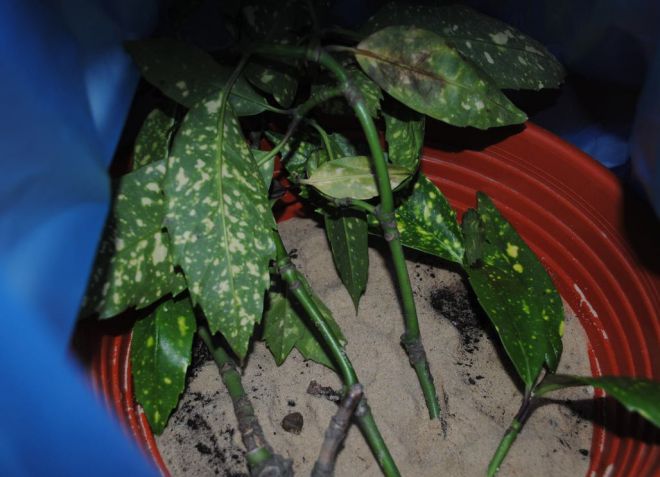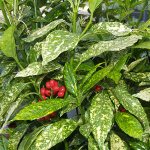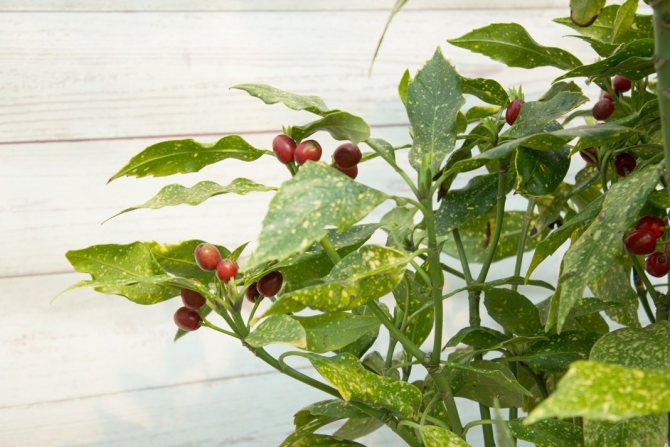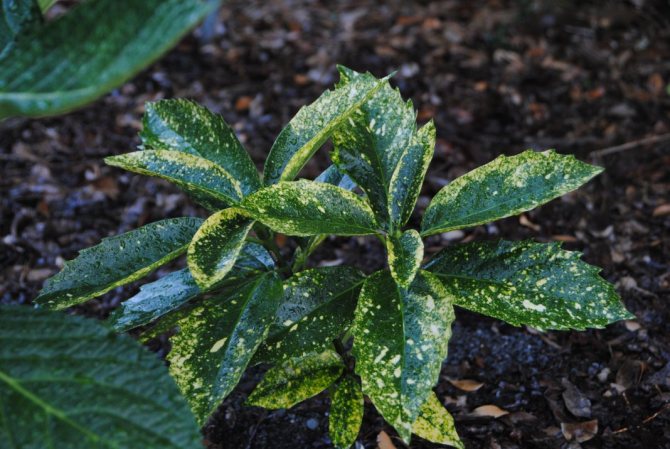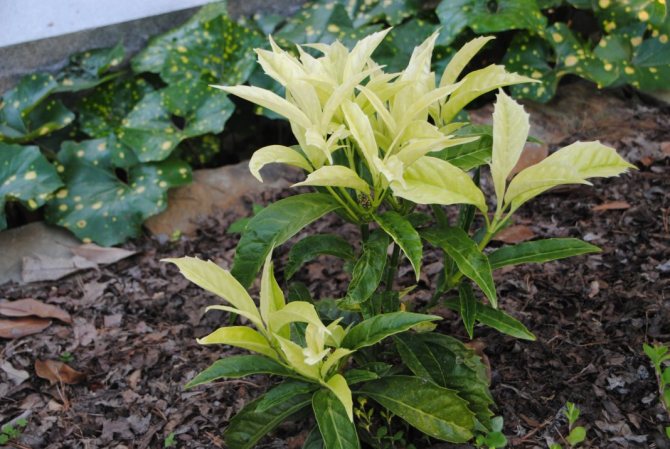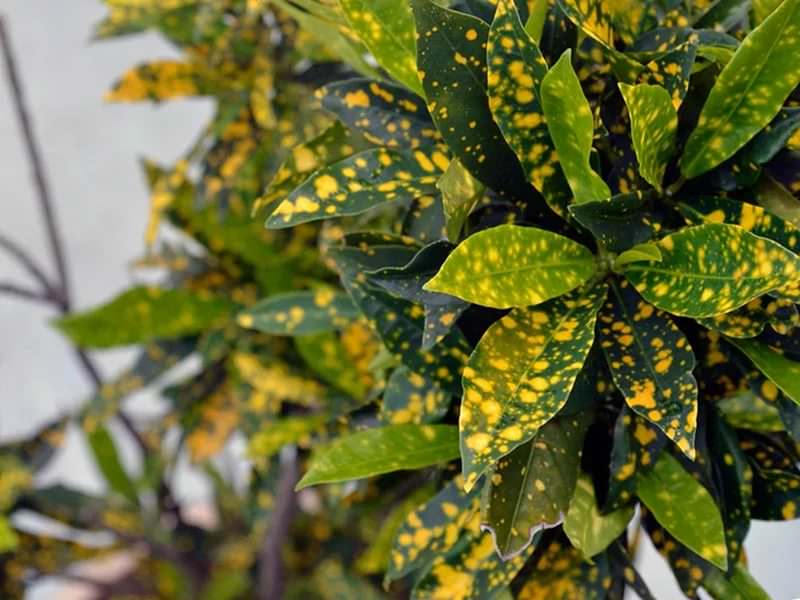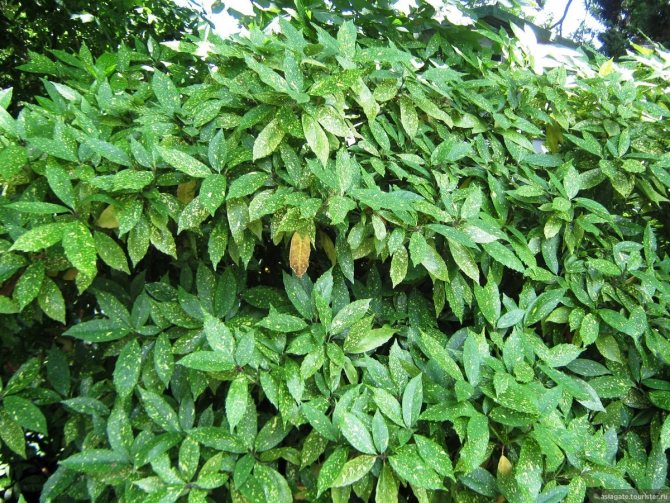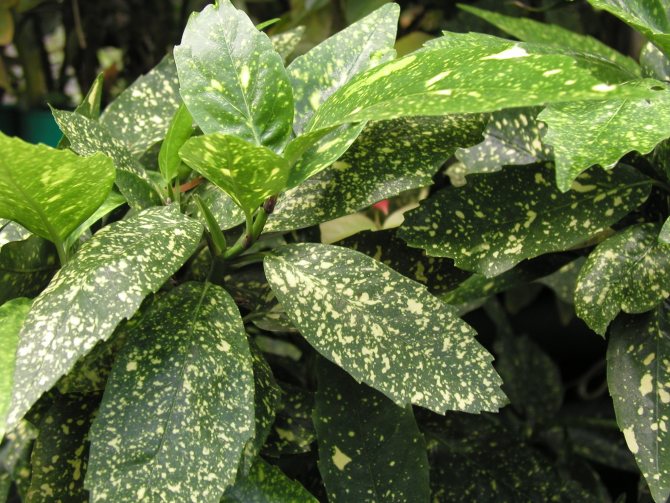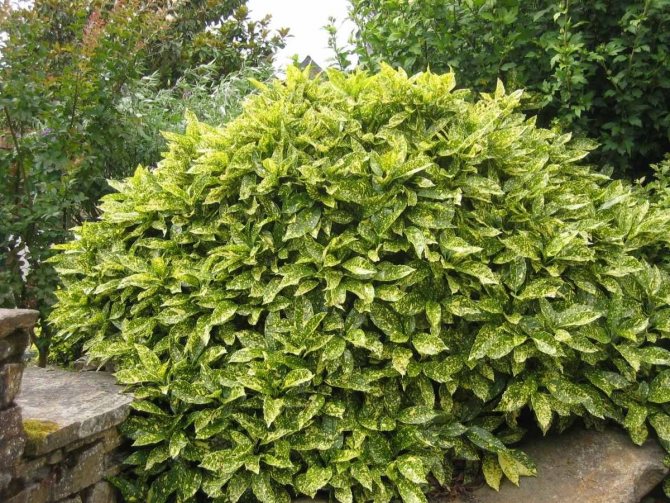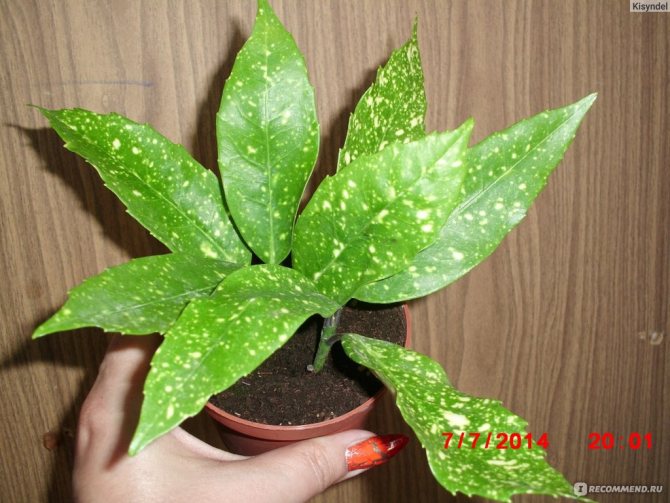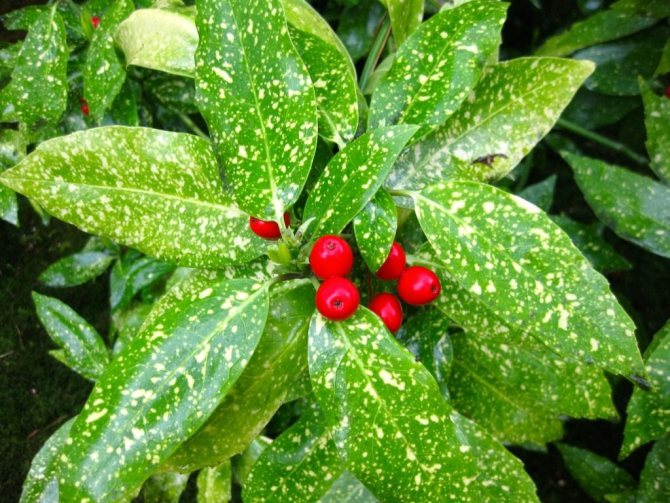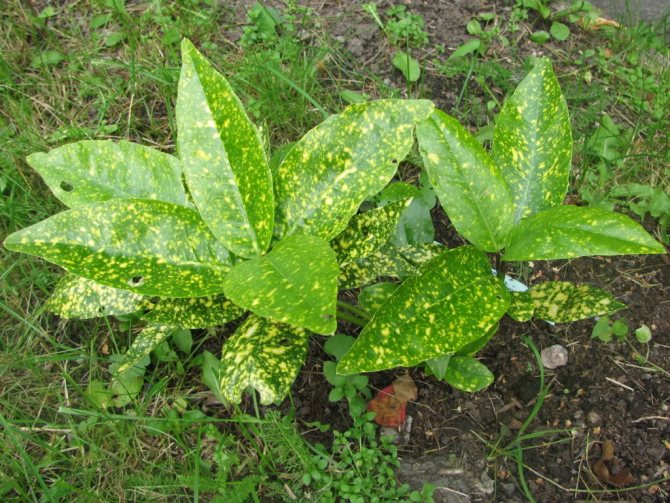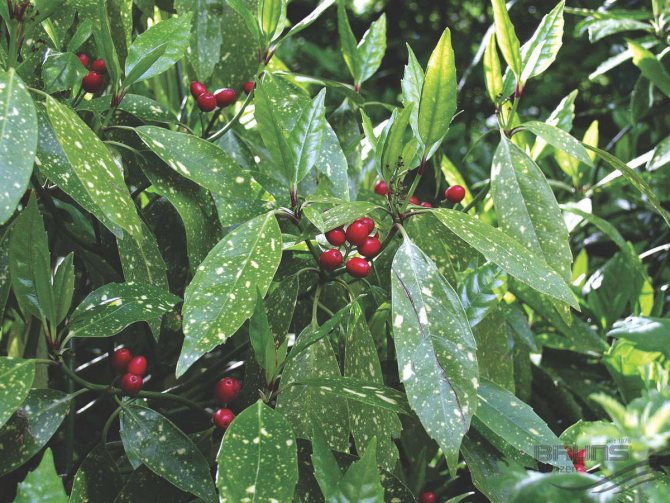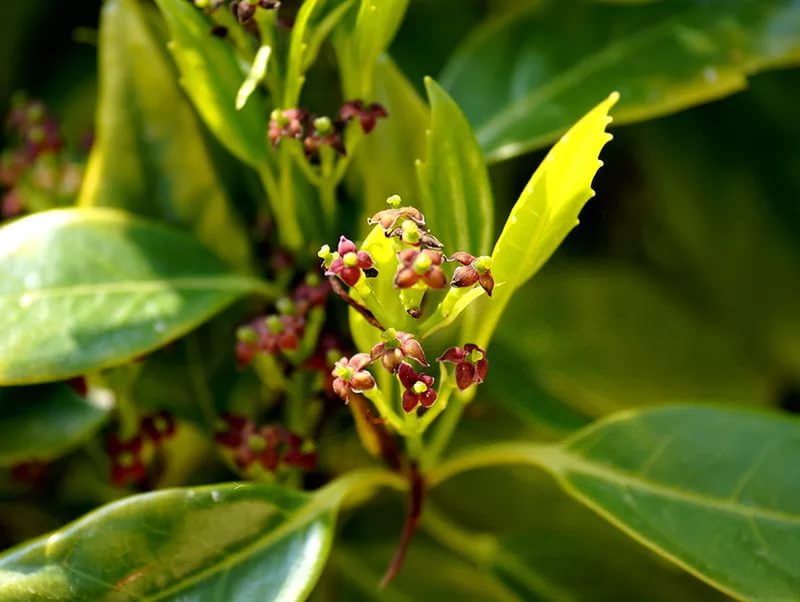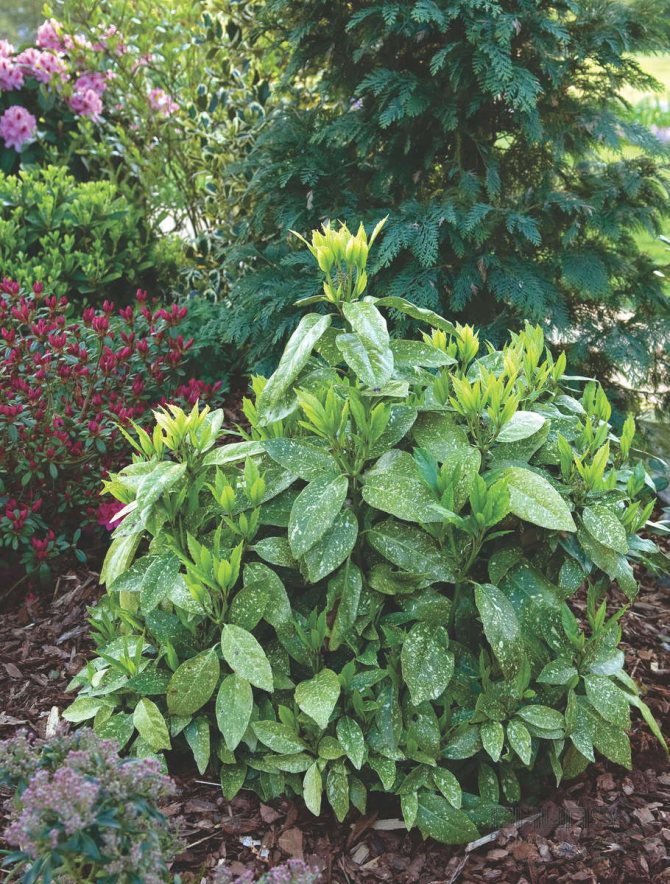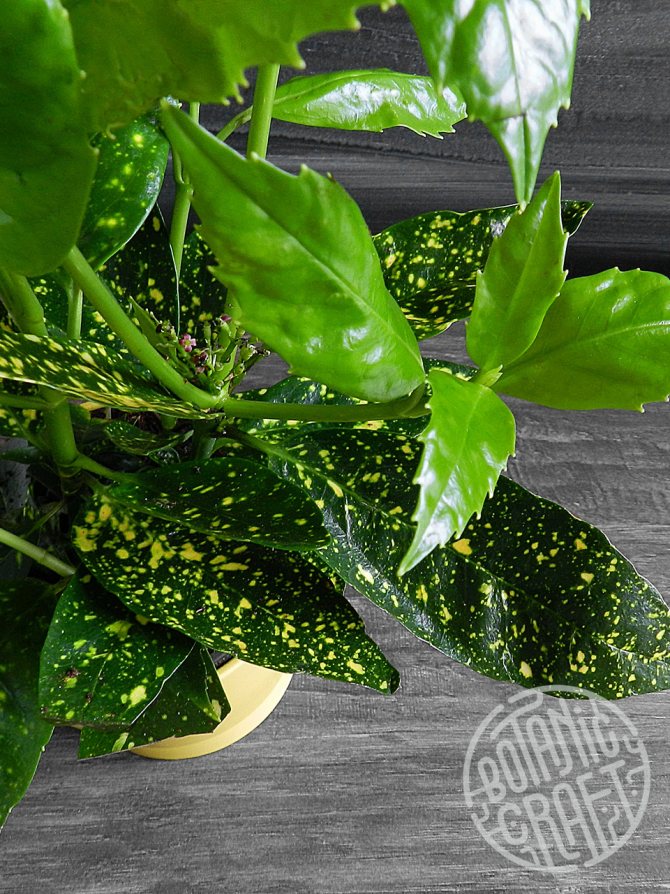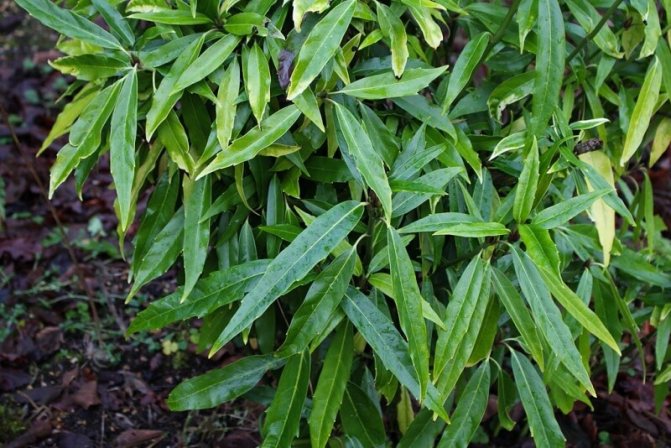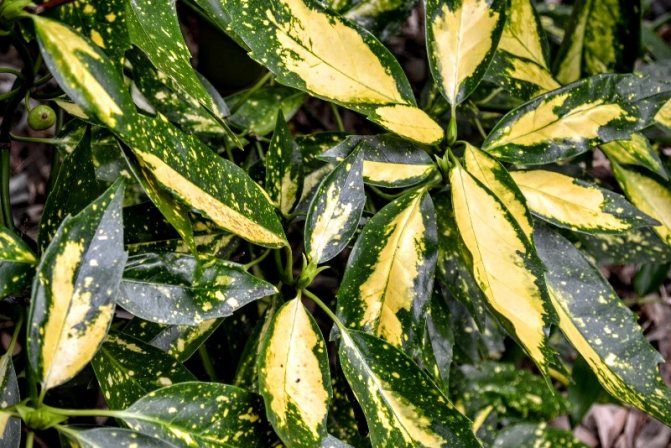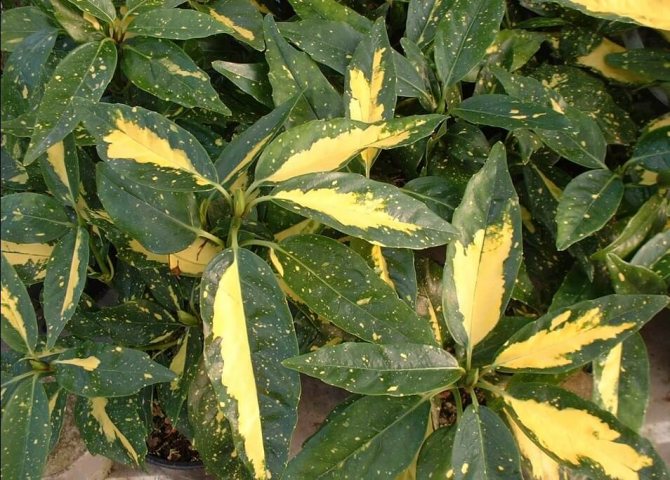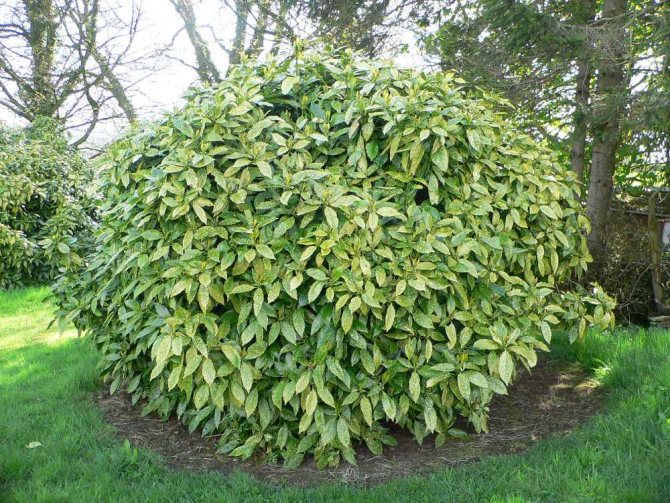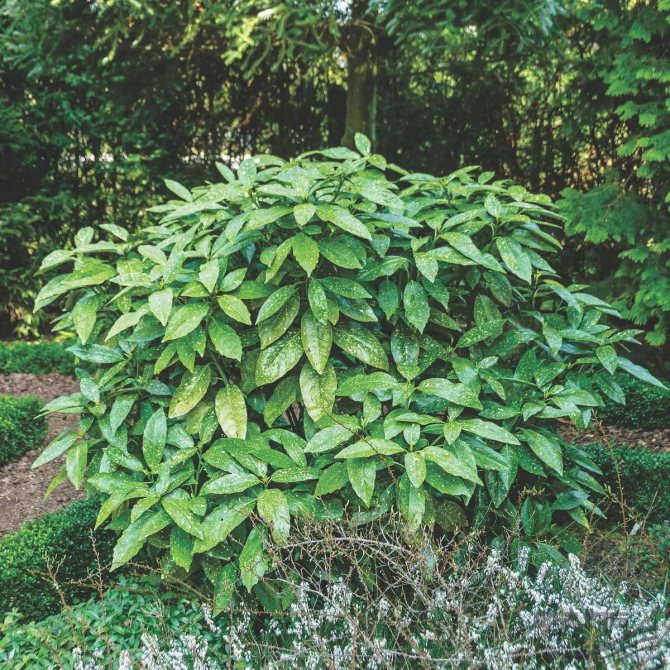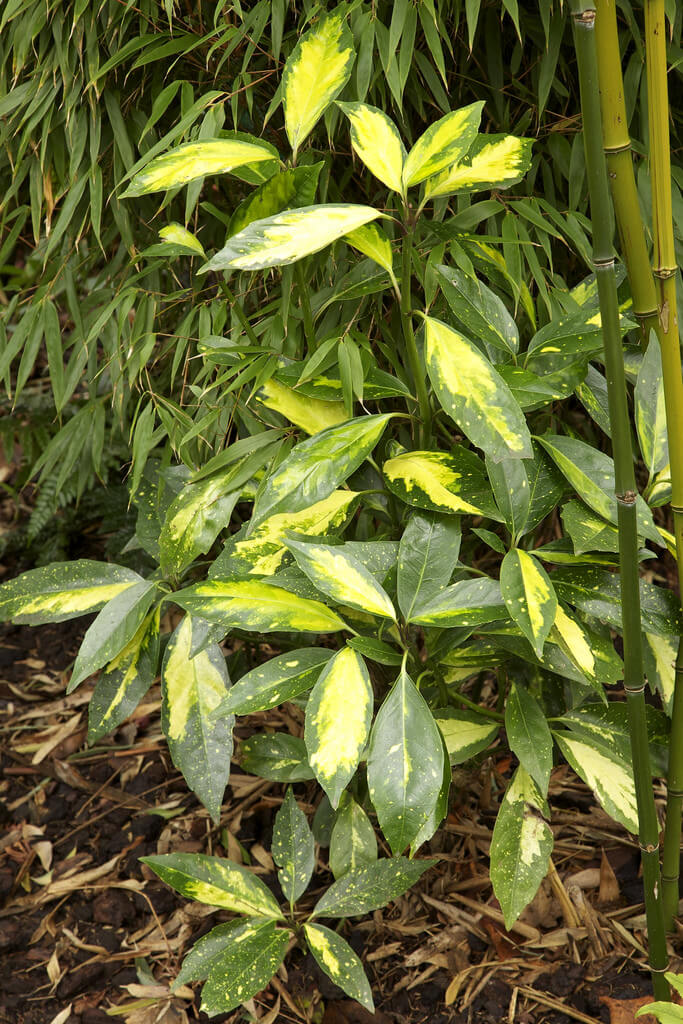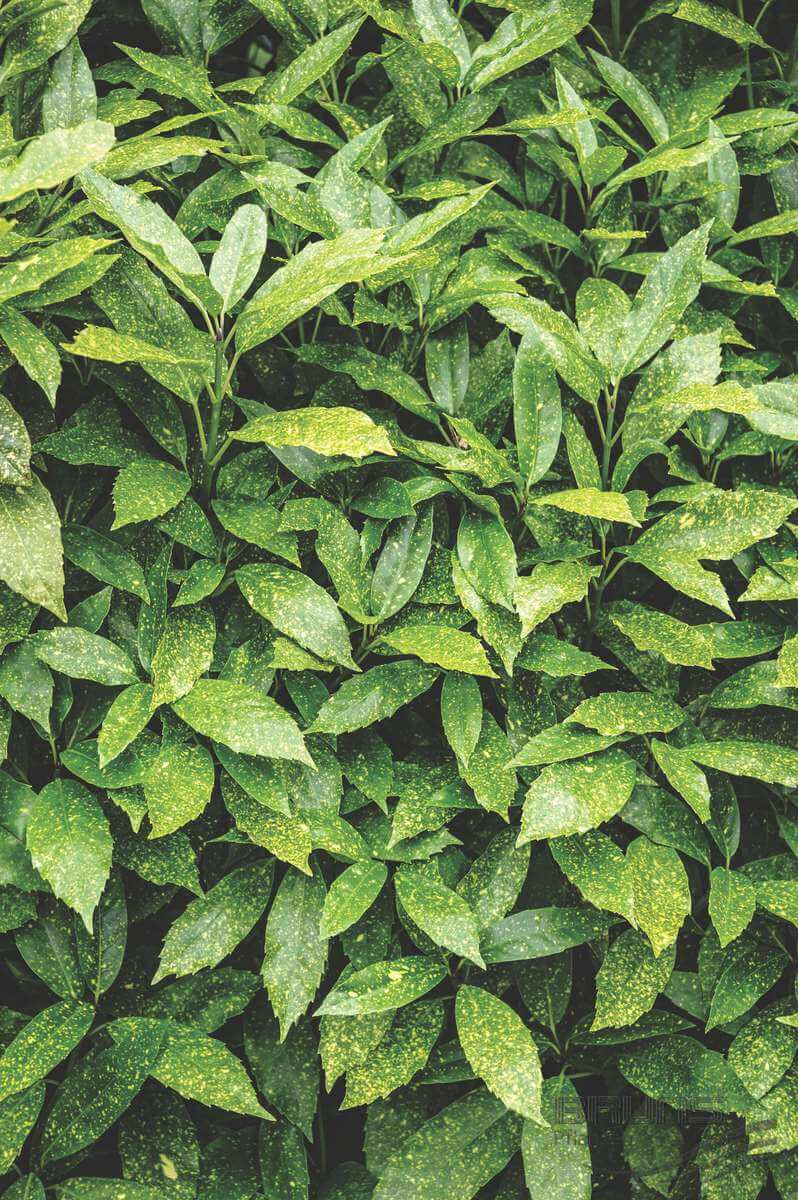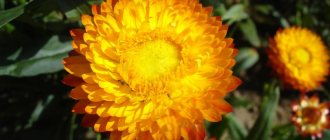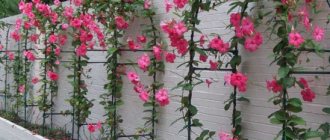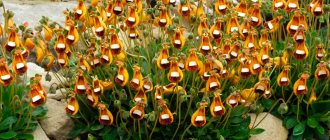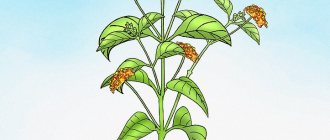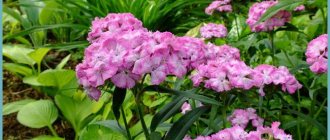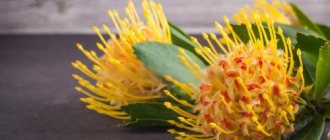What to do right after purchase?
After purchasing, the ornamental bush needs to be transplanted into a large container and placed in a comfortable place with medium illumination. Experts recommend the transshipment method. Aukubu with a clod of earth is moved into a container.
The bottom of the pot is occupied by a drainage layer:
- crushed stone up to 5 cm;
- pieces of styrofoam;
- small pebbles or expanded clay.
Sprinkle the plant with earth. The distance from the edge of the pots to the top layer of the soil should be at least 3-5 cm. Watering is necessary the next day after transshipment.
The shrub needs adaptation to the environment. For at least a week, it is necessary to take care of the plant without abundant watering, top dressing, the bush is kept in a shaded state. Then the pot is transferred to a permanent place.
A universal location for an evergreen plant is the east and west side sills.
The flower is suitable for a temperate climate, without temperature extremes. The bush is unpretentious, it can live not only on a windowsill with enough light, but also in a darkened part of the room. The air temperature in summer is + 18 ... + 20 ° С.
In winter, the permissible values drop to + 8 ... + 14 ° С. It is necessary to ensure that in the cold season the air does not drop to a temperature of less than +5 degrees. The illumination of the aucuba should be dim, the plant should be removed from direct sunlight.
Can I keep it at home?
Aucuba has long been actively used in oriental medicine. The leaves of the plant help with:
- burns;
- frostbite;
They can also be applied to wounds and bruises to reduce pain, disinfect, and promote healing. Plant-based preparations treat gastrointestinal diseases.
Remember that indoor aucuba is dangerous because of its poisonous leaves, flowers, and berries. Care must be taken that children do not touch the flower.
If possible, place the plant pot higher, where the child cannot reach. Talk to the children explaining the danger. After working with a flower (planting, pruning), wash your hands thoroughly with soap and water. The ingestion of plant sap into the stomach (intestines) causes their inflammation and bloody diarrhea.
Planting and transplanting
Aucuba is planted in large ceramic pots. Drainage is placed in the container to avoid stagnation of water, on top is a layer of soil. In the spring after frosts, Japanese aucuba can be grown on the balcony or in garden conditions.
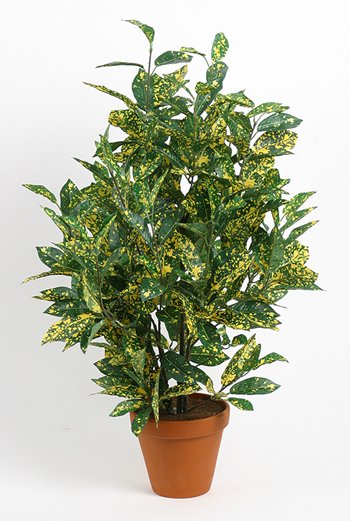
Until the age of 5 years, the aucubus must be transplanted annually. The process is performed in the spring - from March to April. The procedure is recommended to be carried out carefully so as not to injure fragile roots.
The best method is to transfer the plant with a clod of earth to a container with a larger diameter. The bottom of the pot is occupied with a drainage layer and filled with soil. After transplanting, you can trim the leaves or pinch the tops of the shoots.
Adult bushes must be planted when the roots are completely entwined with an earthen ball, that is, every 2-3 years. A more gentle procedure can be carried out - transshipment. This allows the plant to be transferred without damaging the root system. For an adult and overgrown Japanese aucuba, it is recommended to change only the top layer of the earth annually.
Soil requirements
To grow an ornamental plant, you need to prepare the soil. It must contain nutrients. The natural habitat of the aucuba is subtropics, therefore the soil mixture consists of:
- leafy soil;
- clay-sod;
- humus;
- peat land;
- sand in a ratio of 1: 2: 1: 2: 0.5.
A variant of the mixture can consist of turf, sand, humus, peat and leafy soil in a ratio of 2: 1: 1: 1: 1. A prerequisite is filling the bottom of the tank with drainage from expanded clay, pebbles, so that the water easily reaches the root system during irrigation.
Suitable for plant and hydroponic cultivation.
Pests
The houseplant aucuba can be affected by the following diseases:
- Aucuba leaves turn yellow, their tops dry out - an excess of light.
- The leaves become smaller - this means unsaturated soil devoid of nutrients and minerals.
- The lower leaves turn yellow ahead of time, begin to fall off - significant changes in temperature, irregular watering.
- Reduction of yellow spots on leaves - lack of nutrients or light.
- Black spots on the leaves - excess moisture in the soil.
- The crown dries up - being in a room with dry air.
- Thin shoots and stunted growth - lack of nutrition.
Indoor aucuba can be affected by pests such as whitefly, scale insects, mealybugs, spider mites.
Like all leafy species, the aucuba is most often affected by the scale insect and aphids. These pests settle first on the underside of the leaves. And then they cover the entire surface. Leaves from which insects suck all the juice. Become lethargic. Aphids additionally cover them with a sticky bloom.
If you notice signs of pests (black or brown spots) on the plant, treat the foliage with a solution of laundry soap. Then spray it with insecticide. The treatment should be repeated three times, with an interval of 14 days.
It may not be possible to destroy the shield like this. Clean it off with a swab dipped in an alcohol solution.
If a white bloom appears on the leaves, then the aucuba is affected by a spider mite. The plant must be washed and treated with poison.
The appearance of lightened spots is a signal of an infection with thrips, which has settled on the underside of the leaf. The insect spreads at high speed. And its appearance is promoted by high temperature and low humidity. Control measures - treatment with drugs Inta-Vir, Actellik, Decis.
Codiaum, a photo of which indicates decorative beautiful plants with variegated foliage, is rarely damaged by diseases and pests. This is mainly the fault of the gardener. For example, watering a crop with hard water can cause the tips of the leaves to turn yellow.
At the same time, direct sunlight causes burns to the leaves of the plant.
And a couple more nuances to which you should pay attention - when the temperature drops from the recommended values, the edges of the leaf plates turn brown, through the influence of dry air the surface of the leaves turns brown.
Note! The slowdown in plant development can be associated with a deficiency of nutrients in the soil. To restore the required amount of trace elements, carry out an extra feeding.
Of the pests, codiaum affects scale insects, mealybugs, and spider mites. Under the influence of the last parasite, the leaves of the culture begin to turn brown. To prevent the appearance of a pest, constantly spray the plant with a spray bottle, which will maintain high humidity in the room. With a strong spread of parasites, diseased crops are sprayed with the preparations "Actellik", "Karbofos" or "Fitoverm".
Pruning and rejuvenation
Aucuba care includes regular pruning to help shape a beautiful crown. To achieve the density of the aerial part, the shoots are trimmed.The procedure is carried out in mid-spring - from March to April, so that the plants are decorated with berries in winter.
If there is no requirement for mandatory flowering, pruning can be carried out in winter. Excess shoots are removed, the top of the rest of the stems is pinched.
In the first spring after planting, the growth of leaves must be pruned to stimulate the growth of the bush. In formed plants, it is necessary to remove twig-like shoots, dried leaves that spoil the crown. After the procedure, the aucuba bush blooms well.
Pruning is also undertaken to rejuvenate the plant. It allows you to remove stretched and bare branches.
It is necessary to cut off damaged shoots to the base, leaving at least 2-3 live buds on the stumps.
After intensive pruning, the plant begins to develop and release fresh shoots.
Rejuvenation of the bush can be phased: first, half of the stems are removed. After the growth of the shoots, the next batch is removed. The procedure is recommended before the beginning of the period of intensive growth. After pruning, top dressing is required.
How she looks like
Grows in the form of a voluminous shrub or short tree. In nature, it can stretch up to four meters, the height in artificial conditions is one and a half to two meters. Branches are highly branched. The bark is dark green, smooth, often with brownish or red streaks. The lower leaves fall off over time, leaving traces of them on the trunk.
Leaves are attached with petioles, oblong, dark, with various spots and patterns of yellow color. A fold along the main vein is characteristic. The edges of the leaves are uneven, serrate. In nature, flowering begins at the very beginning of spring. The apartment practically does not bloom. Inflorescences are paniculate or racemose, located on the tops of the shoots.
Aucuba is a dioecious plant. For pollination and fruit setting, two bushes are needed - a male and a female. It is almost impossible to get seeds in an apartment. After pollination, the fruits are tied - berries of a deep red color with a single seed inside. The berries are very poisonous!
Top dressing and fertilizers
The plant needs regular feeding to keep the crown decorative. The procedure is carried out from spring to autumn. During this period, the golden tree is in a period of active growth. Experts recommend feeding the aucuba shoots with mineral and organic compounds in dissolved form 3 times a month.
Top dressing is added to the moist soil so as not to harm the root system. The procedure is combined with watering the plant. From spring to the end of summer, top dressing is applied once a week, it is recommended to alternate mineral and organic fertilizers. During the wintering period, the plant is not advised to feed.
Varieties in room culture
Aucuba is not very diverse. Only three plant species are known. Only two of them are suitable for growing in a room. But on the basis of these species, breeders have bred several interesting varieties with increased decorative qualities.
- Aucuba Himalayan. Not very common in culture. Leaves are pure green, elongated, oblong. There is a slight sharpening at the tip of the leaves. The edges are jagged or solid.
- Aukuba is Japanese. The main variety for home cultivation. Stems are woody, green. Leaves are leathery, elongated-oval, oppositely located on the stem. The edges of the leaves are serrated. Based on the species, several hybrid varieties were bred with different locations and sizes of yellow spots.
A perennial plant that does not lose its decorative effect for a long time. In favorable conditions, it lives up to ten years. Young plants develop rapidly, intensively gaining green mass. The average growth per year is 15-20 cm.
Lighting
Aucuba is a shade-tolerant plant, and some forms are shade-loving. Even in deep shade, the aucuba grows well.But in bright sunlight, if they are scattered as much as possible, growth will be no less intense. It is especially important to grow variegated varieties in diffused sunlight, since with a lack of UV radiation, the pattern can be lost, and the entire leaf can burn out. And this means that it will not work to grow aucuba on the northern windows.
In spring and summer, the temperature regime for growing aucuba in indoor conditions is the same and is about 18-20 degrees. If the temperature is higher, the plant will very quickly begin to shed its leaves due to its wear. In winter, the temperature regime should be cooler - about 10-15 degrees. If the summer is not very hot, the aucuba can be taken out into the garden in the shade. It is necessary to ensure that there is no precipitation, draft, direct sun exposure and other negative factors.
Dry air in summer is not harmful for the aucuba. This means that it is not necessary to spray it to increase humidity, but it can be done only occasionally. The opposite is autumn and winter, when it becomes a must. For spraying, soft water at room temperature is selected. For those plants that grow at a lower temperature (range 6-12 degrees), spraying is done carefully, infrequently, so as not to cause an outbreak of fungal diseases.
Regular watering is the key to successful growth and development of the aucuba. If you do not do this, you can not expect that new shoots and foliage will grow. In spring and summer, the amount of moisture should be much higher than in autumn and winter. But you do not need to pour the soil heavily, but you should wait until it dries up a little.
If there is a drought in the pot for a short time, this will not affect the life of the flower. Moreover, short-term soil drying will be tolerated by the ray rather than stagnant water. In winter and autumn, watering of the substrate is organized less often, dosing water in such a way that the earth is periodically wet and dries out from time to time.
Top dressing
An important point in the successful cultivation of aucuba is its regular feeding, which is carried out in the spring and summer, from March to October. When the plant hibernates and is at rest, fertilizing is strongly discouraged. Aucuba is watered with mineral fertilizing every 10 days, choosing universal mineral fertilizers for this.
Pruning
To form a beautiful crown and remove bad shoots, pruning is carried out annually in the stamp. At the same time, you can pinch young shoots. This is the only way to get a dense and lush crown. If the cut shoots are of the apical type, they can be taken for harvesting cuttings and plant propagation.
- Aucuba is planted in wide pots, which are equipped with drainage, since the tree does not like stagnant water.
- Then the soil is poured, the ideal composition of which is as follows: six parts of clay-sod land, two parts of peat and leaf land, part of sand. There are other options for the substrate, for example: part of sand, humus, peat, leafy land, two parts of sod land.
- Aucuba is transplanted every year until the plant is more than five years old.
- When the bush is already an adult, it is practically not transplanted, but this is done only when the substrate inside the pot is completely filled with roots. At the same time, they do not a classic transfer, but a more gentle transshipment. It allows you to keep the roots intact.
How to water?
Regular watering is required to grow and maintain the aesthetic appearance of the bush. Aucuba is a moisture-loving plant, but experts do not recommend pouring the soil abundantly. Therefore, the remaining water is removed from the pot, since the root system of the plant is damaged from excessive moisture. The top level of the ground must be dry.
In the warm season, a decorative flower requires more watering than in the autumn-winter period.From March to October, the shrubs need watering once a week. In autumn and winter, the soil of the plant needs to be moistened once every 2 weeks. The flower tolerates periodic dryness of the soil in a pot, but excessive moisture in the soil can damage the leaves and root system.
Natural conditions for aucuba are humid subtropics, so the plant requires maintaining sufficient air humidity at home. Spraying in summer can be periodic. From autumn to the end of winter, the flower requires regular spraying.
The water required for the procedure should be warm, with a soft structure. When the air temperature drops to + 6 ... + 12 ° C in winter, spraying is carried out less frequently to avoid being affected by fungal diseases.
Unusual properties of aucuba - the influence of the plant on human life
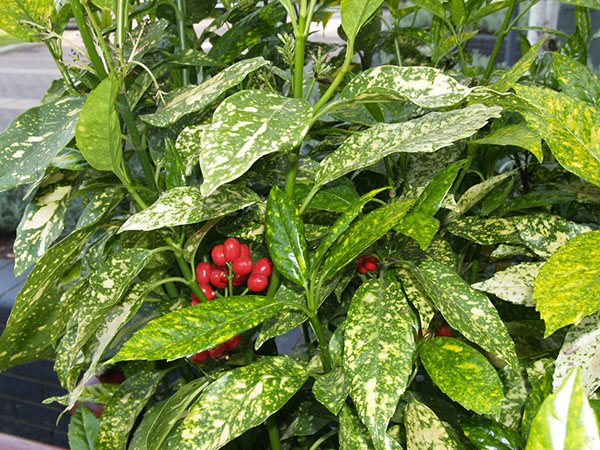

They always walked around exotic, like a precious metal, omens and superstitions. To this day, the shrub is considered the strongest talisman of peace in the family and family relationships. Aucuba creates such a "microclimate" in the house, in which the people living in it feel the cohesion and unity of the family. Positive energy is transmitted from the flower not only to the inhabitants, but also to the visitors of the house.
Another feature of the flower is the ability to attract wealth and happiness into the house. A person caring for a plant is able to find more strength, confidence in himself, to reveal previously unknown potentials. Therefore, experts always recommend giving Aucuba to modest, shy, notorious and insecure people.
Unique properties of aucuba - video
Reproduction
Reproduction of an evergreen plant is carried out using seeds or apical cuttings. Breeding is recommended only with fresh seeds, because during storage, they lose their germination. The planting material is laid out in a container with a substrate from a mixture of peat soil and river sand. It is required to organize a small greenhouse, covering the pot with a plastic bag or glass.
It is recommended to maintain the temperature up to + 21 ° С until the first shoots. Ventilation and frequent spraying of the ground and air are required. After the sprouts appear, seedlings with fresh leaves must be dived into separate containers.
A popular way to propagate aucuba is through cuttings. Material for cuttings is harvested during warm periods:
- from March to April;
- from August to September.
It is necessary to cut off parts of shoots up to 10-20 cm long. Each cuttings should have at least 2-3 leaves. Then the material is placed in moistened sand or a mixture of sand and peat soil. After the roots appear, the cuttings can be planted in containers with a filtered peat and agroperlite-based substrate.
The seedlings should be covered with a plastic bag or glass jar. The recommended temperature for maintenance is + 22 ° С, regular spraying and ventilation is required. After rooting, the cuttings must be planted in separate containers. The required soil for seedlings is a composition with humus, turf soil and sand in a ratio of 1: 1: 0.5.
Discoloration of leaves (pale or light)
Variegated plant species often require more care than plants with green leaves; they always need more light, often more heat and higher humidity. A change in the color of the leaves is always an alarming signal to the grower that it is time to correct the care of flowers.
Lighting is especially important for maintaining variegated color. If a plant with variegated leaves lacks light, then the pattern turns pale, the plant "turns green", as the supply of chlorophyll, formed as a result of the vital process of photosynthesis, increases. The appearance of plants determines what kind of care they need.
- Plants with pale leaf color like a thin shade, i.e.they do not want to stand in dense shade, but they cannot stand the bright sun either.
- Plants with small, leathery or white-covered leaves prefer sun and plenty of light; they will love the south facing window.
- Chlorosis, a disease caused by iron deficiency, is manifested by the light color of the leaves, on which green veins stand out brightly.
- Light spots on the leaves appear when the water temperature is not suitable for irrigation and with strong temperature changes; and also when the leaves are wetted with water in direct sunlight.
- Fungal diseases also leave their mark on the leaves: powdery mildew appears as a white powdery coating on the lower and upper sides of the leaves; gray rot - in the form of a brownish-gray bloom on the upper side of the leaves.
The plant reproduces well by rooting the leaves, for this you can put them in water until the roots appear or rooted in the same way as cuttings in loose soil mixture or peat. The main thing is to ensure regular watering and high humidity (in case of landing in the ground). If the roots appear in the water, it is even easier here: after the leaves have rooted, they are planted in a pot and looked after like an ordinary seedling.
Growing problems
Experts note mistakes in caring for a room aucuba:
- from a lack of watering, the ends of the leaves dry out and become brittle;
- lack of fertilizers and nutrients leads to shredding of foliage after transplanting;
- when the plant is in direct sunlight for a long time, the shoots are covered with burns, which are indicated by brown spots;
- excessively dry air and lack of spraying causes the appearance of dark spots on the leaves.
To eliminate the consequences of improper care, it will be necessary to change the placement conditions for the ornamental aucuba tree.
Diseases and pests
Failure to comply with breeding requirements leads to disease of the bush. Root rot is caused by temperatures less than + 5 ° C and excessive soil moisture. This is due to poorly organized drainage. The plant must be transplanted into a pot, after laying the soil according to the rules. It is also important to reduce the amount of watering.
Aucuba was first brought to Europe back in 1783. She belongs to the dogwood family. The plant, which has a high decorative effect and the ability to easily propagate both by seeds and by cuttings, has rapidly and extensively spread throughout the world.
The flower has found its application as a culture grown in the open field, and a culture that grows as an ornamental plant in indoor conditions. Moreover, it is more widely used in the form of a greenhouse and room culture. The original leaves look especially attractive with yellowish spots of various sizes located on them, which make them look like a gold-bearing rock sample or a sausage slice. From here, apparently, the plant got its name, which is popular among the people, as "sausage tree" and "golden tree".
Location and lighting
For aucuba, bright, diffused sunlight is preferable. Indoor flower, in order to avoid leaf burns, should not be placed in direct sunlight. It can grow well in light partial shade, but artificial lighting is required in winter.
Temperature
In summer, the temperature of about 20 degrees is most suitable for the aucuba. Higher temperatures cause rapid aging and loss of leaves. In the summertime, the aucuba can be taken outside, but it must be placed so that the plant does not fall under the influence of scorching sunlight, rain and wind.
In winter, the preferred air temperature is 8-14 degrees. Indoors, it should not be lower than 5 degrees. If it is impossible to provide a cool wintering for a flower, it must be frequently sprayed and provided with additional illumination.If in winter the air temperature in the room is higher than the indicated values, then the leaves of the plant will begin to fall off.
Air humidity


In summer, the aucuba calmly tolerates dry air, and can be sprayed at will. Spraying with soft and heated water in the autumn - winter period is simply necessary. If the plant is kept in a room in which the temperature is kept from 6 to 12 degrees, then in order to avoid the occurrence of fungal diseases, it is necessary to spray it with extreme caution.
Watering
In the summertime, the aucuba is watered abundantly after each drying of the upper layer of the substrate. And in the fall and winter, the plant requires moderate watering. It should be noted that the flower relatively easily tolerates the state when the earthen lump is overdried, but excessive waterlogging of the soil causes black spots to appear on the leaves.
The soil
The soil most suitable for growing aucuba is a substrate, which includes leaf, clay-sod, peat soil and sand in proportions (2: 6: 2: 1) or the indicated components equally. By the way, hydroponics is well suited for growing aucuba.
Top dressing and fertilizers
During the spring-summer season, the aucuba should be fed weekly with organic and mineral fertilizers, observing their alternation.
Transfer
Aucuba are transplanted in the spring. Young plants require annual replanting. And adults are transplanted in the case of filling the entire flower pot with roots. This is usually done every two to three years.
Transplanting should be done with extreme care so as not to damage very fragile and fragile flower roots. The best option is when the plant with an earthen lump is rolled into a larger pot. Aucuba grows best in wide pots. After transplanting the plant, it is recommended to immediately cut it off or when pinching the upper parts of the shoots.
For reproduction of the aucuba, seeds or its apical cuttings are used.
Seed propagation
With artificial pollination of two heterosexual plants, seeds are formed, which are then used for reproduction. Due to the rapid loss of germination, reproduction should only be carried out with freshly harvested seeds. It should be noted, however, that with this type of reproduction, varietal traits may not be transferred to the new plant.
Sowing seeds is carried out in a container filled with a moist substrate of sand and peat, which must be covered with glass or a transparent plastic bag. Before emergence, it is imperative to maintain an air temperature of about 21 degrees. It is necessary to constantly conduct ventilation and regular spraying. After a while, the seedlings with the leaves that have appeared must be cut into separate pots.
Propagation by cuttings
Cuttings used to propagate a houseplant are cut from March to April, or from August to September. This must be done so that each of them has at least two or three leaves. After that, the cuttings should be placed in wet sand or a mixture of it with peat and covered with a plastic bag. The temperature should be maintained up to 22 degrees with constant spraying and regular ventilation.
After rooting, the cuttings are planted in separate pots with soil, which includes humus, turf soil and sand in proportions (1: 1: 0.5).
Important!
It should be remembered that when working with an aucuba, it is imperative to observe precautions, since the plant is poisonous, including its berries. Poisoning is manifested by inflammation of the gastrointestinal tract, diarrhea and blood in the urine.
- Due to the absence or poorly arranged drainage, waterlogging of the soil occurs, causing black spots on the leaves and rotting of the plant. Therefore, it is very important not to bring the soil to a state of waterlogging.
- Aucuba is often susceptible to pests such as worms.To get rid of them, anti-coccid drugs are used.
- A decrease in the number of yellow spots of color on the leaves indicates that the plant does not have enough light and nutrition.
- Blanching of the leaves is observed when the light is too bright.
- If there is not enough fertilizer, then the leaves become very shallow.
- When the room is very warm and the air is too dry, the leaves of the plant begin to fall off.
- With irregular watering and sharp fluctuations in air temperature, yellowing of the leaves located in the lower part of the plant occurs, followed by their fall.
- With an excess of light, the tops of the leaves dry out and turn yellow.
- Leaves dry out at the edges with insufficient watering in the summer and in the presence of dry air in the winter.
- With extremely warm and dry wintering, dark spots appear on the leaves.
Photo gallery
And only after a lapse of several decades it was possible to bring a male copy to England. After its appearance, the aucuba immediately became widespread. It is used as a greenhouse and indoor culture.
Description
This interesting plant grows in China and Japan, as well as on the Black Sea coast. Translated from Japanese, the plant is called "evergreen".
This tree can reach a height of 2.5 meters. The golden flower is called for the specks on the leaves that glow in the sun like gold. Japanese aucuba begins to bloom at the very beginning of spring. The flowers of the plant are unremarkable, collected in inflorescences. Not every year enters fruiting.
Aukuba is also called a sausage tree because meat was previously smoked in the smoke of its twigs, which gave it an unusual, very pleasant taste. But in fact, the plant is poisonous and dangerous to humans and animals.
By their shape, aucuba bushes are divided into two types. One species has foliage of a monochromatic, juicy green color. The second type is more decorative, with golden spots on the foliage.
The plant is very decorative, easily propagated by cuttings, as well as by seeds. Today, many varieties of aucuba have been bred - for garden and greenhouses. This flower is also grown at home, especially since caring for it is very simple. Simple maintenance rules, easy to follow and your aucuba will be just a luxurious bush.
Varieties of codiaum (croton) in the photo
There are many varieties of codiaum on sale, differing in a variety of colors, petal shape and stem height.
Aucubofolia - The yellow pattern on green leaves resembles the color of the aucuba leaves.
Baron J. de Rotschild - leaves of different ages change color from olive green to pink and orange. As you can see in the photo of Croton, the veins on all leaves of this codiaum variety are underlined in red.
Batic - the leaves seem to be painted using the batik technique.
Bravo - leaves are green with yellow spots.
Norma - the main background of the leaf is green with yellow spots and red veins.
Gold Finger - the leaves are long, narrow, green, with a yellow stripe running along the central vein.
Mrs Iceton - leaves are large, elliptical, young leaf plates are yellow-green, and more "adult" red-orange with a transition to dark green.
Spirale - Red and green leaves are twisted in a spiral.
Yellow Snow - yellow spots on a green background, reminiscent of snow flakes.
There are codiaum varieties, photos of which are presented in our photo gallery, with a less artistic color of the leaves. However, this is offset by their intricate shape.
Golden Bell - leaves with constrictions.
Mammie - the leaf plates are strongly twisted.
Mascarena - the leaves are straight, narrow, but hang down, and not directed like other codiaeum varieties.
Сraigii and Holuffiana are varieties with lobed leaves.
In the decoration of premises, the plant can be used both as a tapeworm and in flower arrangements.
Care rules
Since the plant looks like a dense and slightly rough bush, some growers get the impression that there is practically no need to care for it. In fact, this is not the case. The conditions for keeping this flower in an apartment should be as close to natural as possible.
Aucuba plant will grow well if you follow fairly simple rules:
- Aukuba japonica does not tolerate wind and strong drafts.
- This flower needs moisture.
- Once a year, Japanese Aucuba needs a transplant. This should be done in March.
- The flower needs to be watered regularly and sprayed constantly.
- The flower needs feeding.
- The flower needs regular pruning.
A bit of history
Aukuba Japanese is native to the East Asian forests of the subtropics. It is a small evergreen tree. On sale you most often come across the following varieties: Hillieri, Variegata, Goldiana, Crotonifolia, Dentata.
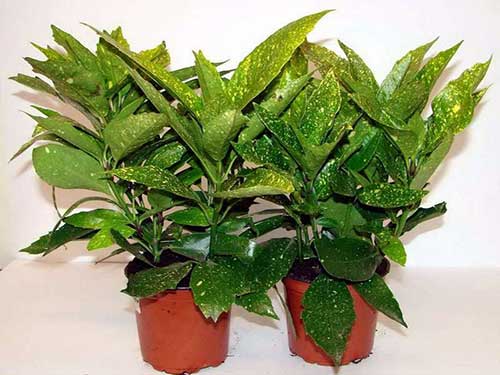

The flower in the home interior began to be found already in the 18th century. Previously, only heard about it from the stories of the inhabitants of the subtropical climatic zone. The inhabitants of Japan were especially lucky, where it was ubiquitous. They could enjoy his unusual appearance even around the clock. But other inhabitants of the planet were allowed to contemplate the beauty of the golden bush only by visiting the vastness of Japan. The indigenous population carefully guarded the plant, believing in its magical healing properties. Export was strictly prohibited.
And only in the 17th century the aucuba was brought to European countries. True, there was a problem with selection. The plant was female, and a male was required for pollination. The situation changed after several decades thanks to the scientist - botanist from England Robert Fortune. He managed to get hold of a male flower sapling.
The transportation of the decorative tree was a rather complicated and costly process. Therefore, the "golden tree" adorned the homes of only the most prosperous people. Gradually, the flower began to gain more and more popularity and distribution among the inhabitants of Europe. They not only learned how to properly care for him, but were also able to significantly increase the number of copies. In the future, everyone could please themselves with the purchase of a golden tree.
Pruning and replanting
The best time to form the crown of the bush is spring. To make the aucuba bush lush, pruning and vaccinations are performed. Shoots cut during pruning can be used for plant propagation. During pruning, they simply remove too long and weak shoots, trying to give the bush a compact, neat shape.
While the bush is young, it is transplanted in the spring every year into a more spacious container. When transplanting, change the soil to a new one. But if the flower is already more than 5 years old, then the soil in the pot should be changed much less often. In this case, you need to navigate by the root system - when the flowerpot is completely filled with roots, it is necessary to transplant into a more spacious pot.
How to achieve a beautiful crown
Don't be afraid to prune the plant! It will only make him better. If in the spring you see many new shoots on the trunk, then it is in your best interest to get rid of them, and it will be easier for the plant to grow.
If you want your plant to have a beautiful crown, then pinch new shoots, because of this, as a result, the shrub will be spreading.
Mandatory requirement: do the transplant with gloves! Don't forget: Aucuba is really poisonous! But this poison is dangerous only if the plant is chewed or in contact with the juice from the trunk or leaves. Not that complicated precautionary rules!
What is the best soil for a golden tree? First of all, it must be loose. A mixture of several components has proven itself well: from peat, leaf part, sand and turf.
Reproduction
The seeds of this plant are difficult to buy. Therefore, many growers propagate aucuba by cuttings.Cutting is the easiest and fastest way to get young bushes. The optimal time for cutting cuttings is August and September or March-April. For cuttings, slightly lignified shoots with several leaves and almost open buds are chosen.
In order for the cuttings to quickly form a root system, they are buried in sand or a peat mixture with sand.
It is advisable to place the cuttings in a small greenhouse, or at least cover them with a jar or cut plastic bottle. Cuttings are regularly sprayed, watered and ventilated. If you do everything right, then very soon the cuttings will develop a strong root system and they will be ready for transplanting into a pot of soil.
Reproduction of aucuba flower


There are 2 breeding options for aucuba:
- by the seed method;
- by cuttings.
For home conditions, the second vegetative method is the simplest and most convenient. The best times for events are spring (early) or late summer and early fall.
First, you need to prepare the cuttings, clean them of foliage, leaving only 2-3 leaves, no more.
In order for the shrub to take root, it is necessary to place it in a sand-peat mixture or moderately wet sand, covered with a film.
From time to time, young shoots need to be ventilated and sprayed, to maintain an optimal temperature regime for them (20-22 °). Rooted seedlings can be dived into pots.
Possible difficulties
- The main difficulty in growing this flower may arise during transplantation. The plant is quite fragile and must be transplanted very carefully. The roots of the aucuba, although fleshy, are very brittle.
- If all the rules of care are not followed, the plant will begin to suffer from non-infectious diseases.
- If the flower does not have enough light, then the number of golden spots on the leaves will decrease. If there is too much light, then the leaves of the plant will become pale.
- If the temperature is too high, the flower may shed its leaves. Also, leaves can fall off due to dry air.
- If on the aucuba the lower leaves began to turn yellow and prematurely fall off, then the reason for this is sharp fluctuations in temperature in the room and irregular watering.
- If the upper part of the leaf dries up, and then the foliage begins to turn yellow and fall off, then the plant suffers from an excess of light.
- If the edges of the leaves dry on the aucuba, then the plant is in a too dry room in winter or it is not watered enough in summer.
- If the leaves began to turn black on the aucubus, then the reason may be too dry and warm wintering indoors.
Aucuba japonica or golden tree belongs to the dogwood (turf) family. It is an evergreen plant with large, leathery, oval, smooth leaves, but small flowers, and reddish, yellowish or white fruits. It grows in Korea and Japan, on the Black Sea coast in the Caucasus and Crimea. Aokiba means always green in Japanese. The height of the tree is up to 2-5 meters. It is called the golden tree because it has the original color of the leaves, which glow like gold under the sun. Aucuba blooms in early spring with dull dark red flowers in inflorescences in the form of a panicle and rarely bears fruit. Japanese aukuba is also called a sausage tree, since even in southeast Asia they loved to smoke small pieces of meat in the smoke of its branches.
This gave the meat a very good taste. The Europeans, having learned about this plant, began to call it "sausage tree" for this. Aucuba japonica is poisonous and hazardous to human and domestic animal health. Look at the Japanese aucuba flower in the photos that are located on this page:
Description of the plant
Aucuba is an evergreen plant with large, leathery leaves gathered in a bunch. In natural conditions of existence (subtropical forests), these are ornamental trees and shrubs.In various sources it is classified as a cornelian or harryaceous family, by some biologists it is distinguished as a genus of aucubaceae.
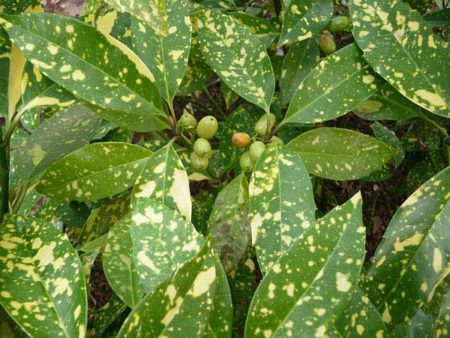

Golden blotches on the leaves give the flower a special appeal. Thanks to these original spots, it got its second name - the golden tree. This houseplant is quite unpretentious, cultivation and care will not require special knowledge and will not take much time.
Caring for Japanese aucuba at home
Japanese aukuba is shade-resistant, gas-smoke-resistant, therefore it is often used for landscaping premises, decorating them in various organizations, as well as central highways in cities. Caring for Japanese aucuba at home includes simple rules for watering, soil selection. You can read about caring for Japanese aucuba at home further on this page. During the period of the most active growth, Japanese aucuba is recommended to be watered regularly and in sufficient quantities, but be careful not to flood this plant. In winter, it is necessary to reduce the number of waterings, especially if the plant is kept in a cool room. When watering Japanese aucuba, you should use soft water that has settled for a sufficient time and does not contain chlorine. You should not allow sudden changes in temperature when growing Japanese aucuba, otherwise its leaves will begin to turn yellow. Did the lower leaves of aucuba japonica turn yellow ahead of time? These are the consequences of irregular watering and large changes in temperature. In winter, it is better to move the tree to a cool place if the aucuba is at home. Japanese aucuba is propagated by cuttings. In order to grow Japanese aucuba, it is advisable to use turf, leafy land and sand. It is possible to grow this plant with a special solution without soil. It will receive all the necessary nutrients from the solution in the quantities that are needed and in the correct amount. Aukuba japonica grows very well when light falls on it, but not a direct beam, but a diffused one. The plant can be in the shade, but much more slowly. It is advisable to place Japanese aukuba in rooms where there is a lot of space, near balcony doors, for example. It develops well on free windowsills, which are located on the north side. In the spring, when the frost passes, the Japanese aucuba should be removed to the balcony or garden, where it is possible to plant the pot in the ground. If you do not want to bury the pot in the ground, then it is better to hide the Japanese aucuba in hot weather from the sun, otherwise the roots will overheat, which will adversely affect the plant as a whole. If you have removed the flower to the balcony or garden, then you do not need to worry about the low air humidity. Aucuba is calm about this. But in winter, in apartments with central heating, the air for the plant will be too dry, so it is better to spray it with water regularly. The roots of Aucuba japonica are very fragile, so it is not recommended to repot it often. The flowers of the Japanese aucuba are small, red, collected in panicle-shaped inflorescences. Of course, they do not decorate the flower. The fruits are small red berries. They taste like dogwood. They are used for culinary purposes. Aucuba is a plant in which male and female flowers are present on different individuals, but male and female plants cannot be distinguished externally until the flowering period. If you grow a male and a female flower not on the street, but in an apartment and place them close to each other, then you can see beautiful red fruits during flowering, which are similar to the fruits of dogwood. It is not just that the Japanese aucuba, which now belongs to the aucubus family, used to be referred to the dogwood family. Bright purple female flowers can be seen in spring. If a male flower is planted next to it, then the female fruits will turn bright red.You can move pollen from a male flower to a female flower by artificial pollination. If you see that there are fewer yellow spots on the leaves, then this means that the plant does not have enough light or feeding. If black spots appear on the leaves, then it means that you water the plant too often.
The magical properties of aucuba
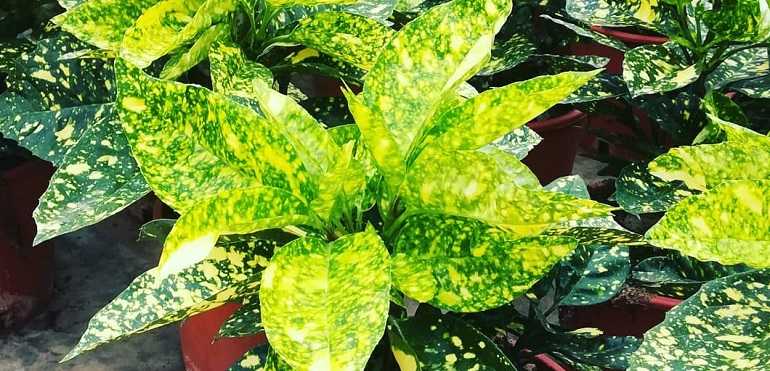

Another characteristic of a flower is the ability to attract wealth and happiness into the house. A person caring for a plant is able to find more strength, determination in himself, to open potentials not previously discovered. Thanks to this, professionals always advise giving aucuba to modest, shy, notorious and self-doubting people.
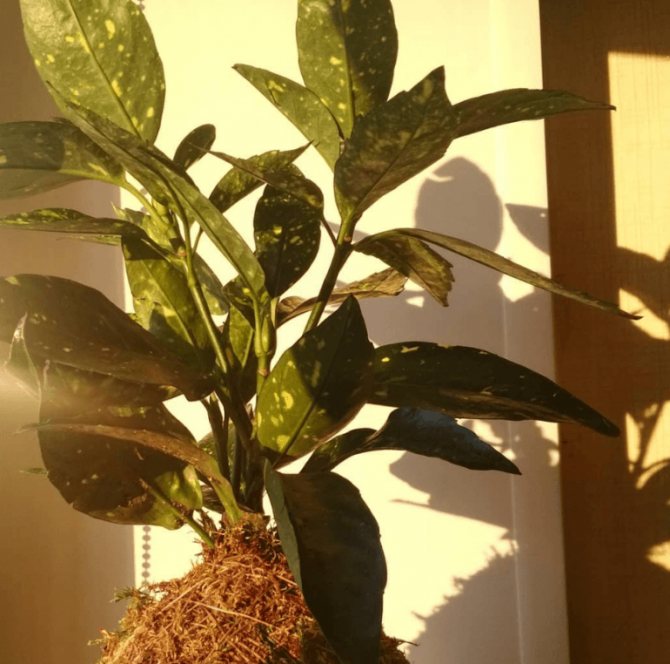

Photo of aucuba on the window
- air purification from harmful bacteria;
- treatment of burns, frostbite, tumors, bruises, on the body;
- treatment of wounds.
Absorbs the negative energy of people, is considered a tree for family well-being. The flower is considered a home mascot in China, Korea and Japan, and more recently in many other countries.
The leaves of the plant contain active substances that destroy harmful bacteria from the air. This is how the air microflora of the room is regulated.
The psychological properties of this plant are also known. It is able to create an atmosphere of calm and cohesion. But it makes braggers listen to others, and it becomes easier to communicate with him. Aucuba protects your home from negative energy brought into it by other people. There is also a belief that no one can offend the owner of a well-groomed plant, it is a kind of amulet for him.
Aucuba leaves are loaded with surfactants that help in the repair of body tissues. In case of injuries and burns, the leaves can be applied to the skin, as they have an anti-inflammatory effect. Also, aucuba will help with frostbite, bruising. For these purposes, crushed plant leaves are used.
A bit of history
The flower in the home interior began to be found already in the 18th century. Previously, only heard about it from the stories of the inhabitants of the subtropical climatic zone. The inhabitants of Japan were especially lucky, where it was ubiquitous.
They could enjoy his unusual appearance even around the clock. But other inhabitants of the planet were allowed to contemplate the beauty of the golden bush only by visiting the vastness of Japan.
And only in the 17th century the aucuba was brought to European countries. True, there was a problem with selection. The plant was female, and a male was required for pollination. The situation changed several decades later thanks to the scientist - botanist from England Robert Fortune. He managed to get hold of a male flower sapling.
The transportation of the decorative tree was a rather complicated and costly process. Therefore, the "golden tree" adorned the homes of only the most prosperous people.
Gradually, the flower began to gain more and more popularity and distribution among the inhabitants of Europe. They not only learned how to properly care for him, but were also able to significantly increase the number of copies.
In the future, everyone could please themselves with the purchase of a golden tree.
There are only 3 large species in the aucubacea family, as well as many subspecies and varieties. In the wild, evergreen shrubs are common in the forests of the Himalayas, the Japanese state, the Korean Peninsula and China.
Japanese Aukuba (A. japonica) - grows in the southern part of the Korean Peninsula. The leaves are large, leathery, have a dark green color or with golden spots, oblong - oval in shape.
The tips of the leaves are found both with denticles and smooth ones. Berries can have not only a red tint, but also white, green. Small flowers are grouped into panicle-shaped inflorescences.
It is better to grow it in a free-standing flowerpot - this way the plant feels better, and you can admire its beauty from all sides.
Recently, scientists have bred a huge variety of varieties of each of the species. They differ in the shape and color of the leaves. Edges can be jagged or smooth. Golden spots can be large and in huge numbers, or they can be completely absent. After dying off, the leaves of the flower turn black. Aucuba foliage is often used in the recipes of traditional healers.
In open soil, the aucuba can reach a height of even 5 meters. In a home environment, the tree grows to a maximum of one and a half meters.
The flower is unpretentious, it can live not only on a windowsill with a sufficient amount of light, but also in a darker part of the room.
So you don't have to worry about allocating a separate place for it among other green fellows in a cramped window sill space.
We list the main points of care:
- Temperature conditions. The tree loves a temperate climate without sudden changes. In the summer season, the required air temperature is 18 - 20 degrees. An increase in performance leads to premature aging and foliage death. During the warm period, the aucuba can be taken out into the fresh air, you just need to protect it from the effects of wind, rain and direct sunlight. In winter, the optimum temperature drops to 8-14 degrees, but should not fall below 5.
- Humidity of the environment. The shrub comes from the subtropics, which means that it needs to provide an appropriate home climate. In the warm season, it is enough to ventilate the room more often in order to maintain optimal conditions for saturating the air with moisture. You can spray occasionally, based on the appearance of the plant. If you don't know what a sufficiently hydrated aucuba looks like, the photo below will tell you that. With the onset of the heating season, the air in the house dries up. In this regard, the tree needs additional surface moisture for normal life. Water for this should be used warm and soft enough. At low temperatures (8 - 12 degrees), care must be taken that spraying does not lead to the appearance of mold.
- The soil. The choice of components for the soil substrate is quite an important point in the home care of Japanese aucuba. The soil should be loose and airy. Soil for evergreen shrubs is combined of peat, soddy - clayey, leafy soil and sand in a ratio of 2: 6: 2: 1. Or they mix humus, peat, sod, leafy earth and sand in a ratio of 1: 1: 2: 1: 1. The golden tree grows quite well in hydroponics.
- Lighting. Bright solar radiation should not fall on the foliage of the plant. The light should be dim, the ideal option is partial shade. If the windows face south, it is forbidden to put the flower on the windowsill - in order to avoid "burning" in the sun. A darkened space is better tolerated by varieties with dark green foliage.
- Watering. In the warm season, watering the Japanese Aucuba should be systematic and abundant, but do not be zealous - there should be no excess water in the pot. In the cold season, watering should be reduced and carried out as the soil dries out. The amount of dressing is applied according to the instructions on the package.
- Fertilizer. The home flower aucuba needs additional feeding in the spring and summer season. Fertilize the soil alternately with organic and mineral additives. Sometimes complex mineral fertilizers are used.
- Pruning. At home, the Japanese aucuba quickly sprouts new shoots, so they need to be slightly pruned in the spring. Pruning correctly will form a lush and beautiful crown. And if you want to contemplate a picturesque spreading plant in your interior, try pinching the ends of the branches. This prompts the flower to release young shoots.
- Transfer. Young individuals should be replanted every spring, but adult overgrown trees should be moved to new soil every few years.The time frame is determined based on the growth of roots around the entire perimeter of the potted soil. It is better to choose a new container for the Japanese aucuba of a large size, so that it is possible to transplant the plant without destroying the earthen lump around the roots. The final stage of transplanting a golden tree is considered to be pruning off excess shoots and pinching the tops of the shoots.
It is worth remembering that Japanese aucuba is a poisonous plant. If precautions are not taken, it can cause vomiting, diarrhea with bloody discharge, and lead to inflammation of the gastrointestinal tract.
Reproduction
The aucubus flower is characterized by reproduction both by seed and cuttings. At home, it is more convenient to use the vegetative method (cuttings). The most optimal breeding period is early spring or late summer - early autumn. Cuttings are prepared, leaving 2 - 3 leaves on them.
Rooting is carried out in moistened sand or peat-sand mixture, covered with a transparent film on top. Periodically, new specimens are aired, sprayed, and also monitored for temperature changes. They should remain within 20 - 22 degrees.
Rooted shoots dive into pots filled with sand, humus and soddy soil (0.5: 1: 1).
Diseases
Aucuba japonica is prone to decay in conditions of excess moisture. It is worth monitoring compliance with moderate watering, as well as the presence of good drainage. Lack of watering also negatively affects the health of the flower - the leaves begin to dry and fall off.
If you notice that the leaves of your tree have become smaller, take care of timely fertilization. Timely spraying also plays an important role in the care of the golden tree.
Look at the appearance of the plant to determine the specific care needs of the plant.
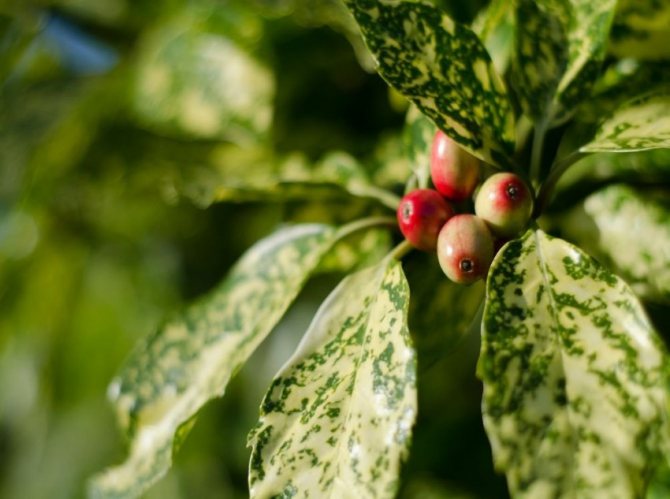

At home, the risk of pests in a flowerpot is small. But in the summer, when moving into an open area, you must carefully monitor the possible appearance of harmful insects. Most often these are thrips, whitefly, scale insects, spider mites, mealybugs. Eliminate pests with the help of special preparations.
A bit of history
Reproduction of Japanese aucuba
Aucuba japonica propagates using cuttings. In this case, they must have at least one or three leaves. The best time to propagate by cuttings is February or March. In this case, it is recommended that the cuttings be placed in a mixture with peat and sand without fail. If there is no peat, then of course only one sand can be used. It is recommended to maintain the temperature for growing in this way at least 20-22 degrees. Those cuttings that can take root, it is advisable to immediately plant one at a time in small flower pots. It is desirable to store them indoors, and not outdoors. Young sprouts are recommended to be transplanted annually into pots that are larger than the previous pots. At the same time, you must be careful with the roots of the plant, since they are very fragile and can be easily broken. It is advisable to replant older plants once every three years.
In a very large in size and age Japanese aucuba, it is imperative to change the topsoil every year. By the way, in pots it can live up to ten years. Japanese aukuba can also be propagated using seeds. But plants grown this way grow much slower. Also, when propagated by seeds, unfortunately, the varietal color of the leaves of the aucuba is not transmitted, therefore its variegated varieties are recommended to be propagated only by cuttings. Experts in the field of biology recommend pruning due to the fact that, thanks to this, the crown of the plant becomes thicker and lush, which attracts the eye of people. In young plants, it is advisable to pinch the growing shoots.This will help the plant to branch out as much as possible, which will also give it splendor and beauty.
Japanese Aucuba (Aucuba japonica)
called the "golden tree" or "sausage tree". This elegant dioecious evergreen belongs to the family
Cornelian cherries (Cornaceae)
... Japan is considered its homeland, in nature it grows in the south of Korea, the southern part of China. For a long time, the Japanese interfered with the export of the "golden tree" from the country. Therefore, the Japanese aucuba came to European countries with a mild climate only by the beginning of the 18th century. Unfortunately, it was a female plant that bloomed but did not bear fruit. Later
English botanist-traveler Robert Fortune
(1812 - 1880) managed to bring female and male Aucubus, making it possible not only to grow, but also to select the best specimens for further reproduction.
There are many yellow spots, strokes and dots on the green leaves of aucuba japonica
In many European countries, Aucuba japonica grows well in gardens and open-air parks. It also exists in our south. In the Moscow region, this plant is grown only as an indoor plant. You cannot leave him outside for the winter.
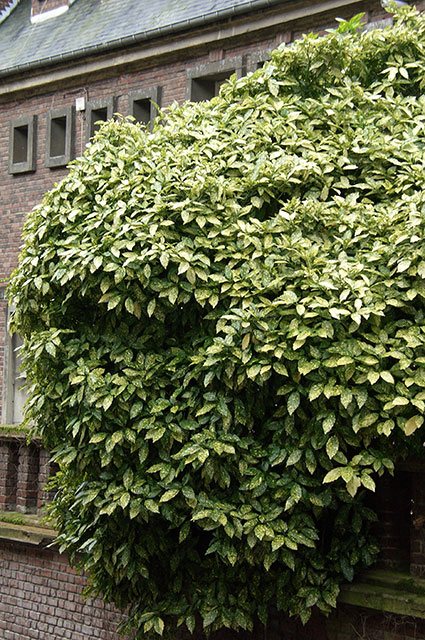

In warm France, Japanese aucuba grows into huge bushes.
Varieties of aucuba
There are only 3 large species in the aucubacea family, as well as many subspecies and varieties. In the wild, evergreen shrubs are common in the forests of the Himalayas, the Japanese state, the Korean Peninsula and China.
The most popular are only 2 types:
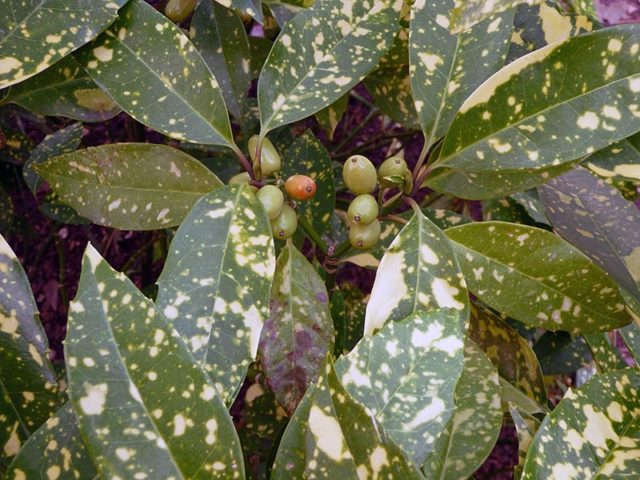

Japanese aucuba (A. japonica) - grows in the southern part of the Korean Peninsula. The leaves are large, leathery, have a dark green color or with golden spots, oblong - oval in shape. The tips of the leaves are found both with denticles and smooth ones. Berries can have not only a red tint, but also white, green. Small flowers are grouped into panicle-shaped inflorescences. It is better to grow it in a free-standing flowerpot - this way the plant feels better, and you can admire its beauty from all sides.


Aucuba Himalayan (A.himalaica) - originated in the forests of the Eastern Himalayas. Adapts well to shaded areas, but prefers diffused sunlight. It blooms in March, the fruits are colored red. The shape of the leaves is oblong-lacent. Periodically, it needs mandatory pruning - new shoots appear quite often.
Recently, scientists have bred a huge variety of varieties of each of the species. They differ in the shape and color of the leaves. Edges can be jagged or smooth. Golden spots can be large and in huge numbers, or they can be completely absent. After dying off, the leaves of the flower turn black. Aucuba foliage is often used in the recipes of traditional healers.
Description of Japanese aucuba
Is everyone guessing why the Japanese aukuba is often called "sausage tree
" or "
golden tree
"? They don't eat it, the bush does not look like sausage either. But the shape and color of a shiny leathery sheet with a jagged or almost smooth edge vaguely resembles thin slices of sausage. In good conditions, many yellow spots and dots form on the sheets. Then the bush looks "golden".
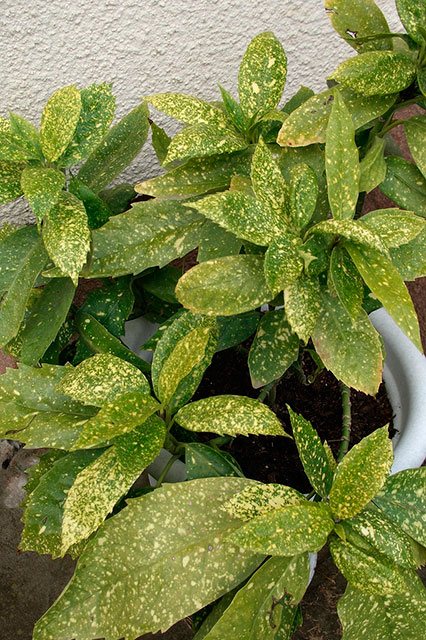

The individual leaves of Aucuba japonica grow very large
Aucuba blooms with inconspicuous small flowers, which are collected in paniculate inflorescences. Orange fruits (drupes) are not worth picking, because they are poisonous.
There are two types of Japanese aucuba: with green
and
variegated leaves
.
Distinguish Japanese aukuba from Aucuba himalaica
, the homeland of which the Eastern Himalayas are considered, can be based on some external features. It has elongated and narrower pointed leaves, and after flowering, starting in March, red fruits ripen.
Description of the genus Aucuba
In appearance, it is an evergreen type shrub with ovoid leathery leaves.Its flowers are collected in a bunch of reddish-brownish color. There are a number of varieties with different colored leaves. There are greens covered with yellowish-golden spots, making the tree appear to be studded with gold. It's very original.
Often in the literature you can find that the people call Aukubu the golden tree. The reason is not only in the leaves. The berries can also be yellow or red and white. In shape, they are somewhat reminiscent of dogwood berries. Plant growth in natural conditions is up to 5 meters, and indoor grows up to a meter.
In China, Japan and the Himalayan mountains, there are three types of aucuba, two of which can be grown at home, for example, these are:
Aucuba himalayan Aucuba himalaica
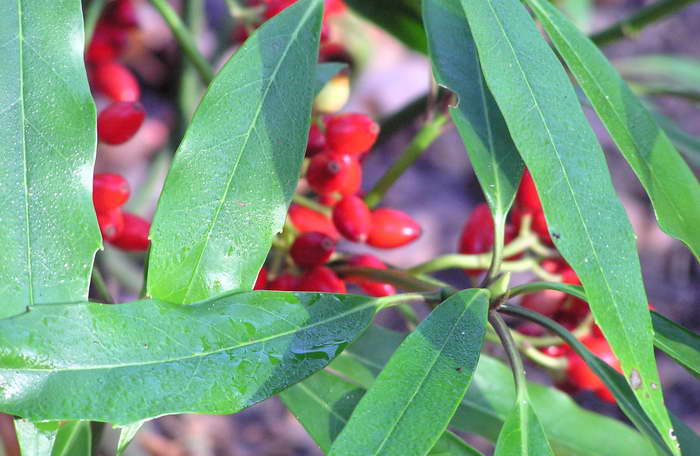

Aucuba himalayan Aucuba himalaica photo
An evergreen shrub that grows to a fairly large size - 3-4 meters. The leaves are dark green and oblong-lanceolate. Some of the leaves have solid edges, while others meet with a serrated edge and a pointed tip with a short or long tooth. The plant does not bloom very well, the flowers are small, ugly, unisexual. Some plants are female and others are male, so they need to be grown in pairs.
Aucuba Japanese Aucuba japonica
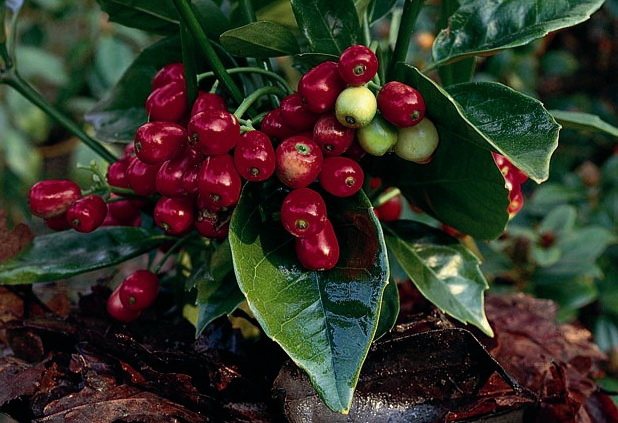

Golden Aucuba tree in the photo Aucuba Japanese Rozannie Japanese Aucuba
Also an evergreen shrub that has green stiff stems with oblong-oval leaves opposite each other. The surface of the leaves is leathery, shiny, the edge is either solid or serrated. The leaves do not have stipules. Depending on the shape, the plant can have all green leaves of the same tone or decorative variegated, covered with white spots. It is for them that flower growers are chasing. The flowers have a nondescript appearance, so they gather in hairy panicles. Flowers are four-membered, dioecious, unisexual, reddish in color. After flowering, an orange or bright red berry is formed, which is crowned by the remaining calyx.
Spraying
Aucuba tolerates dry air well in summer, but poorly when heated in winter.
In spring and summer, the aucuba can be sprayed at will 1 time in 7-10 days. During this period, it tolerates dry air well, especially if it is in the fresh air.
In winter, with the heating devices turned on, daily spraying is necessary, in the morning or in the evening. For this, warm, settled water and a fine-grained spray bottle are used.
If the temperature of the content at this time is below 12 degrees, spraying should be carried out less often and more carefully.to eliminate the appearance of mold and fungal diseases.
Temperature
The Golden Tree prefers moderate temperatures. In spring and summer, it is optimal to keep the aucuba at 18-20 degrees. In winter, it is recommended to lower the temperature to 10-14 degrees, but not below 7. If the thermometer readings are much higher, there is a possibility that the plant will lose its beautiful decorative appearance and begin to shed its leaves.
If it is not possible to provide cool conditions in winter, regular spraying and good lighting are necessary.... Aucuba is afraid of drafts and sudden changes in temperature, therefore, when airing it, it is better to remove it away from open windows and vents.
What is Aucuba sick with?
If watered incorrectly, the plant can be affected by rot. This comes from waterlogged soil and too cold content.
Root rot stains the root system brown-red, the plant stops feeding and it dies at high speed. It is most often affected by young, fragile specimens. Prevention - proper care, adherence to temperature and watering regimes. If the plant is sick, it can be saved, but only in the initial stages. A heavily affected specimen will die for sure.
Remove the plant from the pot, rinse the roots and trim the affected areas. Change pot and soil.Water a little after transplanting.
Mister Summer Resident: Aucuba Assistant
The flower not only looks beautiful, but also has healing properties. The foliage of the bush contains useful elements that contribute to the destruction of pathogenic microorganisms in the air.
The plant is used in alternative medicine to treat injuries, burns, frostbite. Aucuba compresses are applied to the affected area and changed regularly. They reduce pain, disinfect wounds, and promote early healing. In addition, various diseases of the gastrointestinal tract are treated with preparations containing aucuba extract. In this case, it is very important to observe the dosages indicated in the prescription, consult a doctor in advance so as not to harm your health.
The Japanese believe that the plant is beneficial for family relationships. It brings relatives closer and unites. Thanks to the shrubs, peace, understanding and harmony will reign in the house.
Buying a flower brings prosperity not only to family members, but also to apartment guests. In addition, the aucuba helps to get rid of the negative energy brought into the home by ill-wishers.
According to an ancient Japanese legend, the plant attracts luck and wealth to the family. Caring for an indoor flower promotes a surge of vitality, helps to unleash potential, and gives self-confidence. Aucuba will be a wonderful gift for an indecisive and withdrawn person.
Reproduction of Japanese shrub
There are three ways to get new plant specimens:
- dividing the bush;
- layering;
- seeds;
- cuttings.
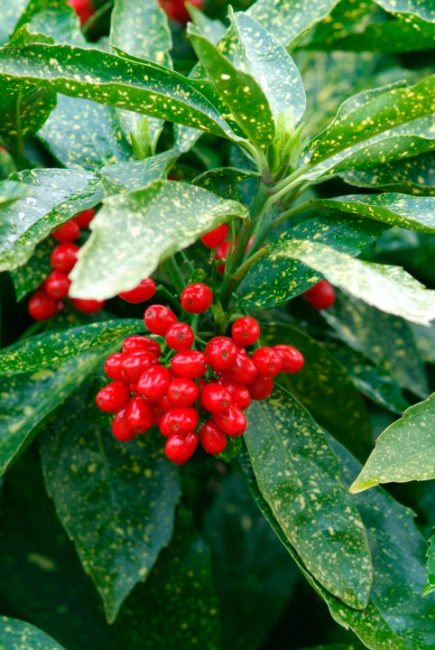

The division of the bush is carried out during transplantation. The advantage of the method lies in the complete preservation of the floor and decorative qualities of the new specimen. In indoor floriculture, this method is rarely used. Well-groomed plants do not overgrow and rarely form many growths.
Layers are formed from branches with aerial roots at the bottom. You can just dig in a twig. Regular moistening of the substrate contributes to the appearance of roots. After some time, the twig is carefully separated from the mother bush.
Seeds are sown in March-April, when the plants enter the flowering and vigorous growth phase. The main disadvantage of the seed method is the inability to predict the sex of future seedlings. Determination of sex is possible only during the flowering of the aucuba, since according to other signs, heterosexual plants are almost impossible to distinguish. It is considered unproductive to grow seedlings to maturity.
Cuttings are considered to be the most effective way to breed the golden tree. The advantage of the method is in full compliance with the parent specimen in terms of sex and decorative qualities. Cuttings are obtained from mature shoots. Twigs with aerial roots are preferred, which awaken in abundance from the nodes at the bottom of the bush.
Views
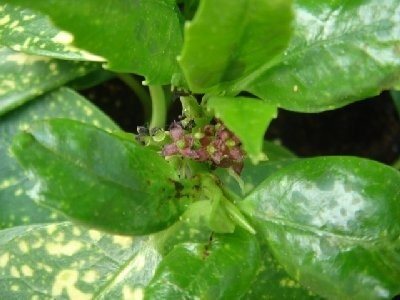

Compared to other plants, the aucuba is few in number. But modern breeders have bred varieties that differ in the color of the foliage. On some, the spots cover only the center of the leaf, while others are covered with a scattering of small specks. There are even species in which the greens break through only along the very edge, and the entire plate is gold.
The most famous and often found in indoor floriculture are two types:
Japanese
In nature, it grows in Japan and Korea. Forms of this type differ in the location and size of the spots. It has oval leaves with a smooth surface. The length of the leaves reaches 20 centimeters. Plant height under favorable conditions reaches two meters. The flowers of the plant are bright, deep red, collected in fluffy panicles. Fruiting is rare. Berries on it can form not only red, but also yellow and white. A beautiful crown of this species can only be formed by regular pruning. This is the most common type. You can admire the plants of this species in the photos below.
Himalayan
This species comes from the Eastern Himalayas. In home cultivation, it is much less common. Differs from Japanese in thin, sharp leaves of dark green color. Rugged edges. Forms fast-growing shoots that require timely pruning. Photos of Aukuba Himalayan are posted below.
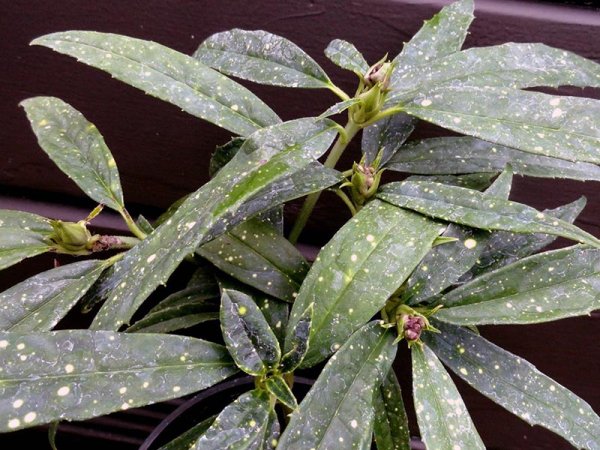

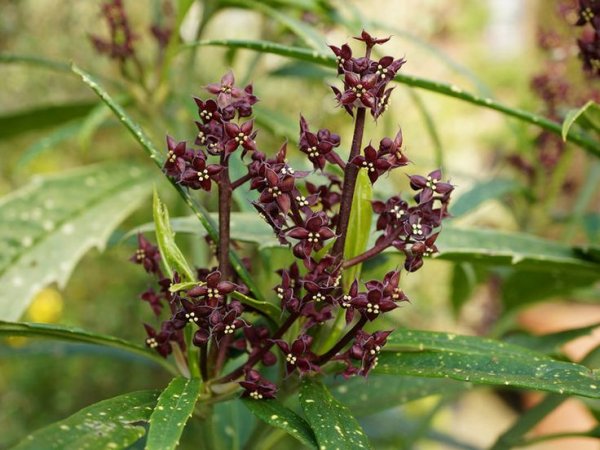

Is Aucuba dangerous at home?
Aucuba is a poisonous flower, therefore, keeping it in a house with children or pets is not recommended. The poison is found in all parts of the plant!
ATTENTION. It is forbidden to grow aucuba in child care!
Aucuba in the garden
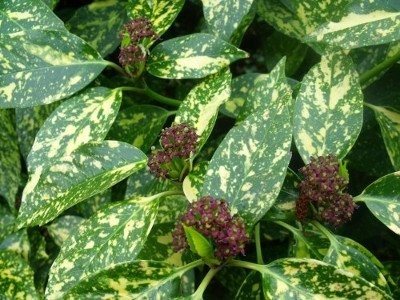

In the open field, the "golden tree" is able to grow in the area of the Black Sea coast. This evergreen shrub grows up to five meters. Forms a lush, strongly leafy shape. Resistant to environmental conditions. Grown in slightly acidic soils. It can grow in sunny and shaded places.
Diseases
Most often, aucuba is affected by various rot., one of the manifestations of which is the appearance of black spots on the leaves. The reason why the leaves of the aucuba turn black is excessive moisture. The solution is to regulate watering, remove the affected parts, treat the plant with a fungicide.
Of the pests, the scabbard, spider mite, mealybug can pose a threat to the "golden tree".
If insects are found, the plant can be wiped several times with a swab dipped in soapy water. If this does not help, an insecticide should be applied - Nurell-D, Aktellik, Fitoverm.
Diseases and pests, control methods
Most often, Aucuba suffers from root and gray rot. These fungal infections occur due to excessive watering, inappropriate soil composition. If you identify the problem in time, you can save the plant by adjusting the care. Emergency transplants are undesirable. Due to trauma to the root system, the aucubus may die.
Of the pests, the culture is affected:
- mealybug;
- spider mite.
You can get rid of them with the help of insecticides:
- Actellik;
- Green soap;
- Fitoverm;
- Decis;
- Aktara;
- Karbofos.
Fertilizers and soil for aucuba
During the growth period, which runs from spring to autumn, once a week, fertilizing with organic and mineral fertilizers is carried out, alternating them.
A soil made up of six parts of clay-sod land, one part of sand and two equal parts of leaf and peat land, or two parts of sod land and in equal parts of leafy, peat, humus land and sand will serve as an ideal substrate for the aucuba houseplant. Also thrives when grown hydroponically.
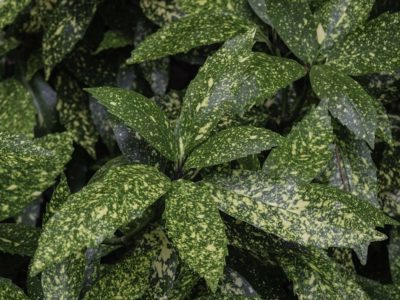

How to propagate
Growing an aucuba in a pot at home requires periodic plant replacement. In the absence of proper formation and simply due to age, the lower part of the branches is gradually bare. It is better to think in time about growing a new plant to replace the old one. There are only two breeding methods.
Seeds
Seed propagation is a complex process. Seeds lose their germination very quickly, so they are usually sown immediately after harvest. But since it is almost impossible to get them at home, one has to hope for the germination of store seeds. It is better to sow with a reserve - only a small part can rise.
Seeds are sown in a peat-sand mixture, covered with glass or film on top. The temperature for the period of germination of the seeds of the aucuba is kept moderate - about 21-22 ° С. The glass is removed daily, the greenhouse is ventilated, and the soil is sprayed if necessary.
With the appearance of sprouts, the shelter is removed. The grown aucuba seedlings can be transplanted into separate containers. At first, they adhere to a gentle care regimen, they gradually accustom to bright light and abundant watering.
Cuttings
It is much easier to propagate aucuba by cuttings in water or in soil. In the reviews and on the forums, there is information that the aucuba takes longer to take root in the water, but in the future the plant develops faster.
Cuttings are cut in early spring or closer to autumn.At least two leaves are left on each cutting. The lower cut can be treated with Heteroauxin or Kornevin to accelerate the appearance of roots.
The treated cuttings are placed in a glass of water with the addition of an activated carbon tablet or immediately dropped into light soil. When rooting in the ground, a shelter made of polyethylene or glass is used. In both cases, the temperature is kept at 22 ° C.
After the roots appear, the cuttings are transplanted into separate small pots. Young plants are carefully cared for until they show stable growth signs. Then they are gradually rebuilt to standard care, as for adult plants.
Transfer
It is better to replant the plant in the spring. For young bushes, this procedure is carried out every 12 months, and once every 2-3 years it will be enough for mature ones, as needed. Aucuba should be transferred with great care so as not to damage the roots. It is more convenient to carry out this by the transshipment method, in which the earth lump is preserved. The pot should be taken larger than the previous one, and always wide. After completing the transplant, the plant should be pruned and pinned at the tops of the stems.
In the case when the aucuba grows to a large size, a full-fledged transplant can be changed to renew the upper layer of the substrate. As a rule, from 5 to 7 centimeters of earth is subject to replacement. In this case, the plant can live in the same pot for up to 10 years. By the way, the larger the pot, the more the bush itself will grow. But in this case, you will have to wait decently - first, the root system will fully develop, and then the green mass will begin to grow.
During transplantation, one should not forget about the removal of rotting or already dead roots. Having cut off the parts with a pre-processed tool, the cut site will have to be processed with crushed coal or chalk. It will take 2 to 3 hours outdoors to dry.
Growing problems
With proper care, the aucuba practically does not cause problems with cultivation. There are some points to pay attention to.
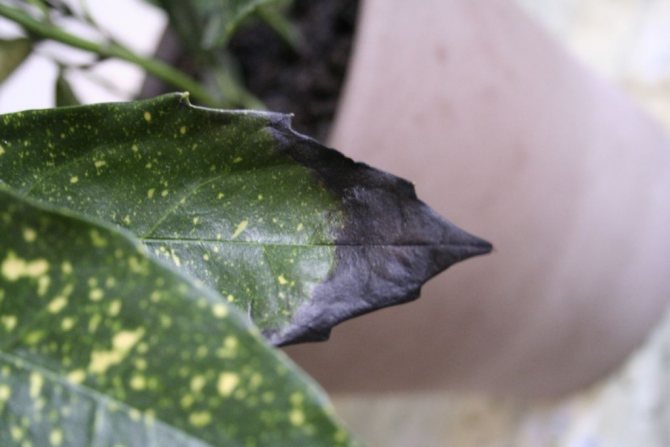

The foliage turns black
Shedding foliage and buds
The flower lacks moisture, so it sheds foliage to distribute the feeding process. It is worth adjusting the watering.
Pale leaves
The lighting is likely to be overly bright. You need to move the pot to partial shade.
Dry tips
Insufficient watering and moisture. First, the leaves begin to turn yellow, then dry. You must either turn on a humidifier or spray the flower.
Falling foliage
There is not enough feeding. In this case, the leaves first become smaller, then they begin to fall.
Lighting
Aucuba can grow both in partial shade and in diffused light. It is important to avoid exposure to scorching sunlight.... In this case, the need for lighting depends on the type and variety.
So, specimens with solid green leaves easily tolerate partial shade and can successfully grow on northern windows.
But for variegated varieties, the window sills facing east or west will be the best place. Due to a lack of light, the leaves may fade, and the pattern on them will be lost.
In the summer, the pot can be taken out into the open air: into the garden or onto the balcony. In this case, it is important to first take care of a place protected from precipitation and the scorching sun.
Trim / Support / Garter
Let's take a look at how to properly prune an aucuba. In the spring, before the start of active growth, it is recommended to prune the overgrown shoots. This will create a lush and dense crown and give the bush the desired shape.
In young plants, it is advisable to pinch new shoots - this stimulates better branching.
The plant has a high growth rate. Its shoots can elongate by 15-20 cm annually. Without forming, this tree quickly reaches a height of 2-2.5 m.Therefore, the annual formative pruning is a mandatory procedure when caring for the aucuba in order to preserve its decorative effect and compact shape.
Aucuba tolerates pruning well. Every year, the longest shoots are shortened by 1/3, and the unbranched ones are pinched. It is also necessary to cut dry and diseased shoots, cut out branches growing inside the crown.
Healing properties
Bouvardia flower: home care and propagation methods
The aucuba plant not only has a beautiful appearance. The foliage contains active substances that bring incredible benefits to both humans and the world around them:
- Destruction of harmful bacteria and microorganisms in the room,
- Regulation of air microflora to the required parameters,
- Quick assistant to a person with injuries and burns, tumors and frostbite.
- Create a peaceful and warm atmosphere at home.
Note! All parts of the flower are poisonous, therefore, when compiling a recipe, you must strictly adhere to the recommended proportions.
Growing conditions
Pachistachis care at home
In order for the aucuba to develop successfully, it, like any other plant, needs to create suitable conditions.
At home
Lighting should be sufficient, but diffused. Moreover, the tree will have to be protected from direct sunlight, otherwise the leaves will suffer from burns. In principle, the aucuba is capable of evolving even with partial shade. In winter, the amount of light should also be normal - you will have to use additional fluorescent lamps. In the warm season, the plant feels good at a temperature of 20 degrees. Its increase will lead to the fact that the shrub grows and begins to lose leaves.
The rest period is carried out at a temperature of 8 to 14 degrees. A decrease in the indicator below 5 degrees will lead to the death of the plant. If wintering is carried out in a well-heated room, then the leaves will additionally have to be moistened by spraying from a sprayer. The liquid must be heated and free of impurities.
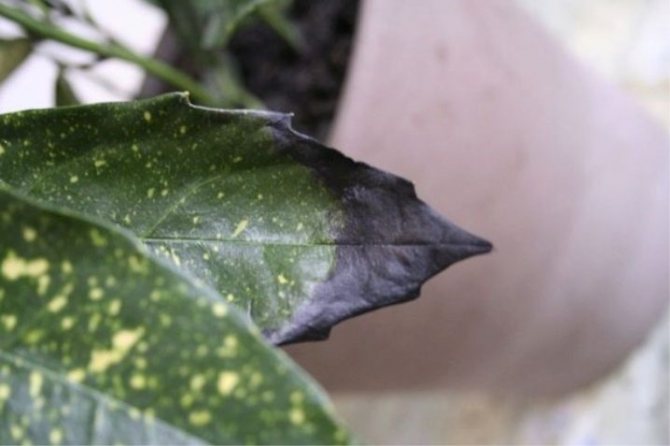

The most suitable soil mixture is a mixture of leafy soil, clay-turf, peat and sand. The components are taken in a ratio of 2: 6: 2: 1. Alternatively, you can mix leafy earth, peat, turf, humus and sand, which are used in a ratio of 1: 1: 2: 1: 1. It is not forbidden to mix the components in equal proportions. Some growers prefer to develop aucuba hydroponically.
In the open field
The conditions for growing aucuba in the garden are not very specific. The place should be well lit, but not exposed to direct sunlight. Protection from precipitation and strong winds is also important.
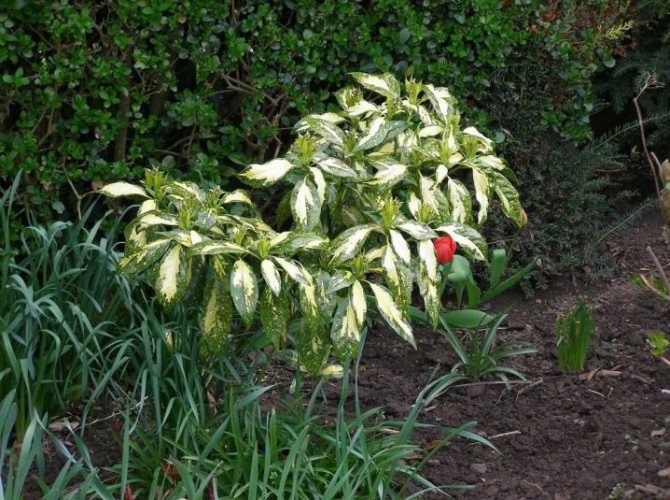

Types of aucuba home with photos and names
There are about 8 varieties of evergreens that grow in the vastness of the planet, from the Himalayas to Japan. But the most popular are 2 of them.
Aukuba Japanese
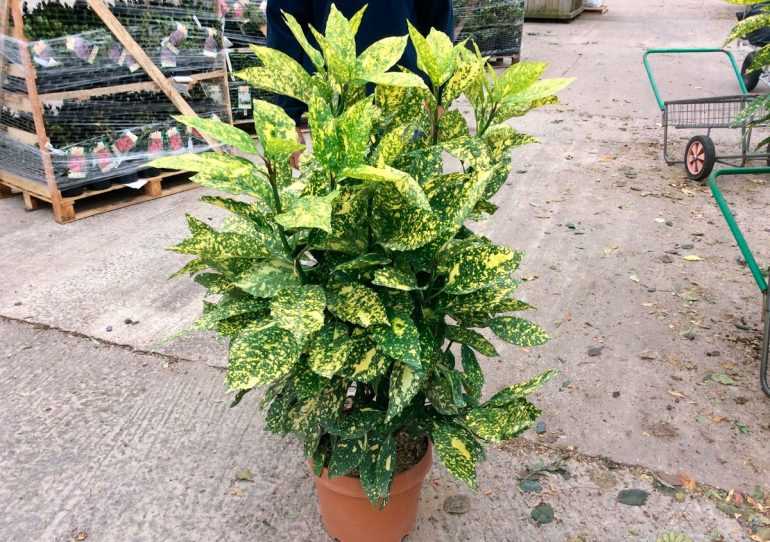

A plant with oval smooth leaves up to 20 centimeters in size. If it exists in favorable conditions for the plant, its height can reach 2 meters. During the flowering period, bright red panicles appear.
Fruiting is very rare. May produce white, yellow, red berries. Regular pruning allows for a beautiful crown. The Japanese differs from the other species in the location and size of the spots, and is more common.
Features of the
Aucuba, also often referred to as the "golden tree," is familiar to many growers as a houseplant or greenhouse plant. It looks unusual due to its beautiful leaves covered with golden spots. In nature, it develops in the territories of eastern countries - South Korea, China or Japan. Although there are about a dozen types of aucuba, it is customary to choose only 2 of them for home use - Himalayan and Japanese.
The Himalayan aucuba reaches 4 meters in height and is characterized by the presence of leaves with teeth.On the Japanese aucuba, long 20-centimeter leaves appear, monochromatic or covered with specks.
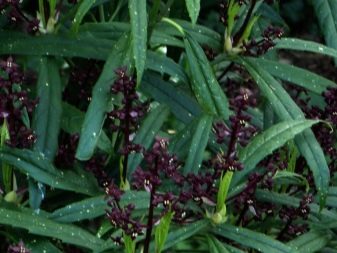

A general description of the Aucuba species suggests that the culture can be like a tree or a shrub. If you do not carry out regular pruning, then the maximum height will be 1.5-2 meters. For a year, the "golden tree" grows by 15-20 centimeters. In indoor conditions, the aucuba can live for about 10 years. Leathery leaves grow oval or slightly elongated.
The glossy surface is painted green or red-brown. In some varieties, it is covered with a scattering of yellow specks of various sizes and shapes. The aucuba flower is colored red. Small buds form apical inflorescences. Fruiting is carried out using red or orange berries.
Varieties and varieties of Aukuba
"Crotonifoli" with large glossy green leaves covered with yellow-cream spots.
"Golden King", the leaves of which are covered with large golden spots. Prefers a partially shaded area.
"Gold dust" and "Goldstrike" with dark green foliage in small golden specks.
Rozannie. A compact shrub with male and female flowers, after the flowering of which large fruits are tied. The shiny dark green leaves have jagged edges.
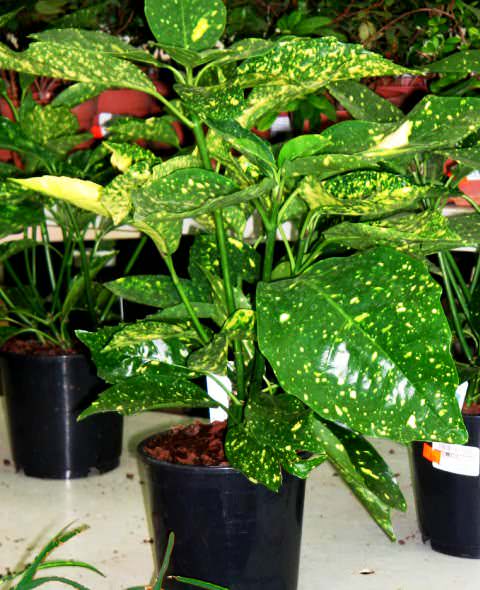

"Variegata" has leaves densely mottled with gold spots. The leaves of this variety are slightly wider than those of other species.
“Pictura” with a large yellow spot in the middle of the leaf, surrounded by numerous small spots.
There are varietal forms with solid green leaves, but gardeners prefer to grow beautiful variegated varieties.
Humidity
Aucuba prefers medium humidity - above 50%... In summer, it tolerates dry air well, but in winter, special procedures to increase humidity will not interfere.
If the plant hibernates at room temperature with the heaters on.
What can be done?
- Putting a damp cloth on batteries;
- Place the pot in a container filled with damp pebbles, expanded clay or sphagnum moss;
- Spray aucuba;
- Use a humidifier;
- Place containers with water around the flower.
Possible problems
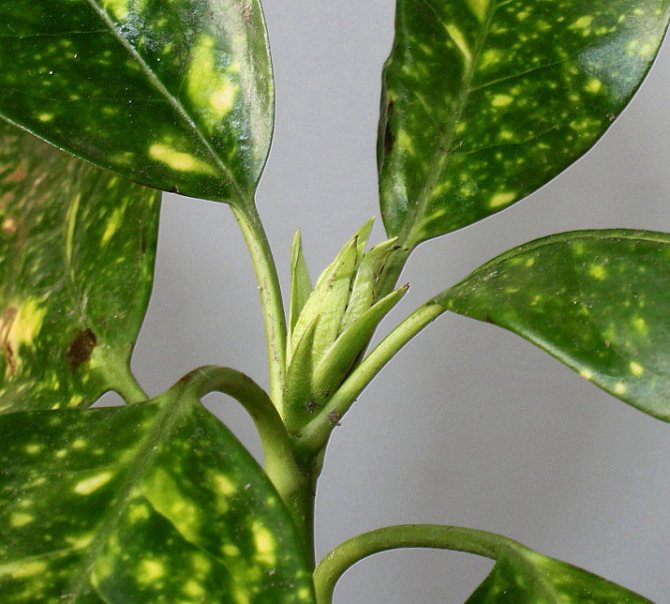

With improper care or inappropriate growing conditions with room aucuba, the following problems can begin:
- Aucuba leaves turn pale... This occurs when the lighting is overly intense.
- Foliage loses its pattern... The plant lacks light.
- Foliage shrinking... The bush feels a lack of nutrients, in order to correct this, apply fertilizer to the substrate systematically.
- Flying around foliage... This can be caused by too dry air or excessively high air temperature.
- Yellowing and flying around the lower leaf plates... This may be due to improper watering or a sharp change in temperature.
- The edges and tops of the leaf plates dry out... This can happen due to excessively low air humidity (in winter), due to too bright lighting, or due to the fact that the bush feels an acute lack of moisture.
- Black specks on foliage... This problem appears when the plant overwinters in a warm room, where the air is very dry.
- Pests... Mealybugs, scale insects, spider mites and whiteflies can settle on the bush.
Aucuba in the house: signs and superstitions
The Golden Tree also has a special energy. It can bring family members together, give a sense of unity. It is especially useful for people with high self-esteem to keep their culture. She creates an atmosphere of calm and peacefulness. Even communication with unfamiliar people who come to the house will be easy, without unpleasant moments, if there is an aucuba nearby.
It is believed that it is useful to give the plant to people born under the sign of Virgo. It is also suitable as a gift for a modest, insecure person.It is believed that the aucuba reliably protects its owner from insults, helps to reveal abilities and express themselves.
Aucuba is an evergreen tree that is popular with flower growers for its decorative foliage that fits into any interior. It does not require complex maintenance. But in order for the plant to be healthy and retain its attractiveness, it is necessary to create a suitable microclimate for its life.
Want to know more about growing Aucuba at home? Watch the following video:
Watering and humidity
In the summer, we provide abundant watering, so that during the breaks, from the first and second watering, the upper layer of the substrate dries up a little, and in the autumn-winter period, moderate watering is carried out. The plant will tolerate the relative drying of the earthen coma well, but excessive moisture in the soil will cause the appearance of black spots on the leaves.
He is calm about the dryness of the air in summer, especially adult specimens, so spraying is done at will, and in the autumn-winter period, spraying is simply necessary. Spraying is done with warm and soft water. When this plant is kept in a room with a temperature limit of 6 to 12 degrees, the spraying procedure itself is carried out in the most accurate way or excluded altogether in order to avoid mold.
How to care
Caring for a plant at home includes basic processes such as fertilizing, irrigating, and pruning. However, it should be remembered that the plant is poisonous, so work must be carried out using protective equipment.
Top dressing
Fertilization is carried out from spring to summer, during a period when the plant is actively developing. Feeding the aucuba once a week is enough. Both humate-based organic matter and mineral fertilizers are suitable - it is best to use them alternately. The dosage and consumption of substances should be taken from the instructions attached to the package. Any top dressing is combined with irrigation. While the aucuba is at rest, no fertilization should be applied.
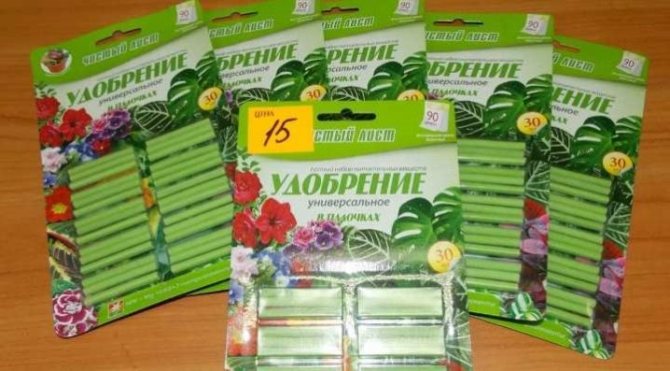

Watering
Watering the aucuba should be done heartily throughout the spring and summer. The frequency is determined by the state of the top layer of the soil - as soon as it is dry, irrigation can be carried out. Its height is 2-3 centimeters. During the autumn-winter period, the amount of moisture used decreases.
Pruning
The formation of the crown is carried out in March, when the dormant period of the aucuba ends. Such pruning has a more decorative function, since the shoots are cut off at the top, and the lateral young shoots are also pinched. As a result, the bush takes on a more beautiful shape and splendor. Cut off shoots, by the way, can be immediately used for propagation by cuttings.
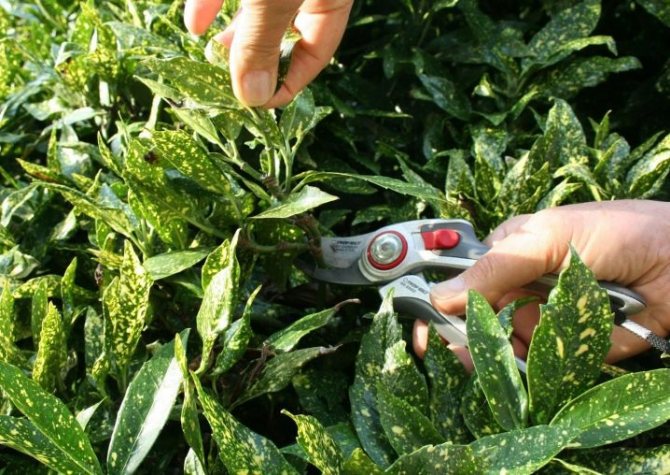

Growing aucuba
The Japanese aucuba prefers warmth within + 22-23 ° С, it does not like noticeable temperature fluctuations, drafts. In summer, it can be moved outside in a garden in the shade or on a ventilated balcony. At the same time, it is necessary to place the bush so as not to harm it by the sun's rays, wind and rain. For wintering, you can find a cooler place with conditions of + 10-14 ° C, but the temperature should not drop below + 6 ° C. The flowers and leaves of the Japanese aucuba acquire decorativeness under shaded lighting. So its plates better preserve the variegation of the leaf.
Aucuba - ground
In order for a healthy evergreen aucuba to grow at home, it is better to plant such indoor flowers in light soil. The substrate can be prepared independently: mix turf, leafy soil (or humus), moistened peat and coarse sand in equal proportions. There must be a hole in the vessel and good drainage, otherwise the foliage on the shoots will be covered with brownish spots from the stagnation of the liquid.
How to propagate an aucuba?
The decorative leafy aucuba japonica propagates in two ways:
- Seeds.At home, high-quality seed can only be obtained if there are two heterosexual plants, otherwise the embryos of seeds in the fruits will not form. On some bushes, flowers have stamens, on others - pistils, the culture must be manually pollinated with a cotton swab. Seeds lose their germination very quickly, so there is no point in storing them.
Freshly harvested grains are soaked for several hours, sown in a wide container with moistened peat and covered with glass. The container is placed in a warm place, systematically ventilated and moistened with soil. When 3-4 leaves appear on the sprouts, the covering material can be removed. The sprouts are transplanted into soil consisting of turf, humus and sand in a 2: 1: 1 combination. When propagated by seeds, the variegation of the leaves may not be preserved;
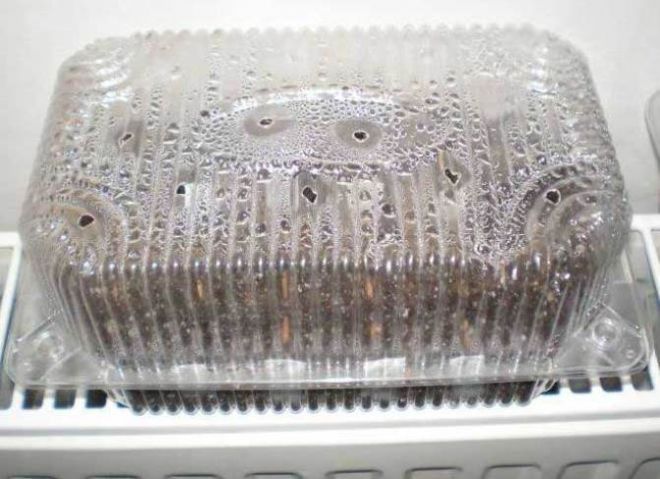

Cuttings. This is a faster breeding method. The procedure is carried out in February or March. When propagating by cuttings, a shoot with 2-3 leaves is separated from a mature aucuba and placed in a wet peat-sand mixture, covered with cellophane or a plastic bottle. When the seedling has roots, small leaves will grow on it. The fortified stalk is planted in a separate vessel with soil made of earth, sand and peat, the tops of it are immediately pinched to form a dense crown.
